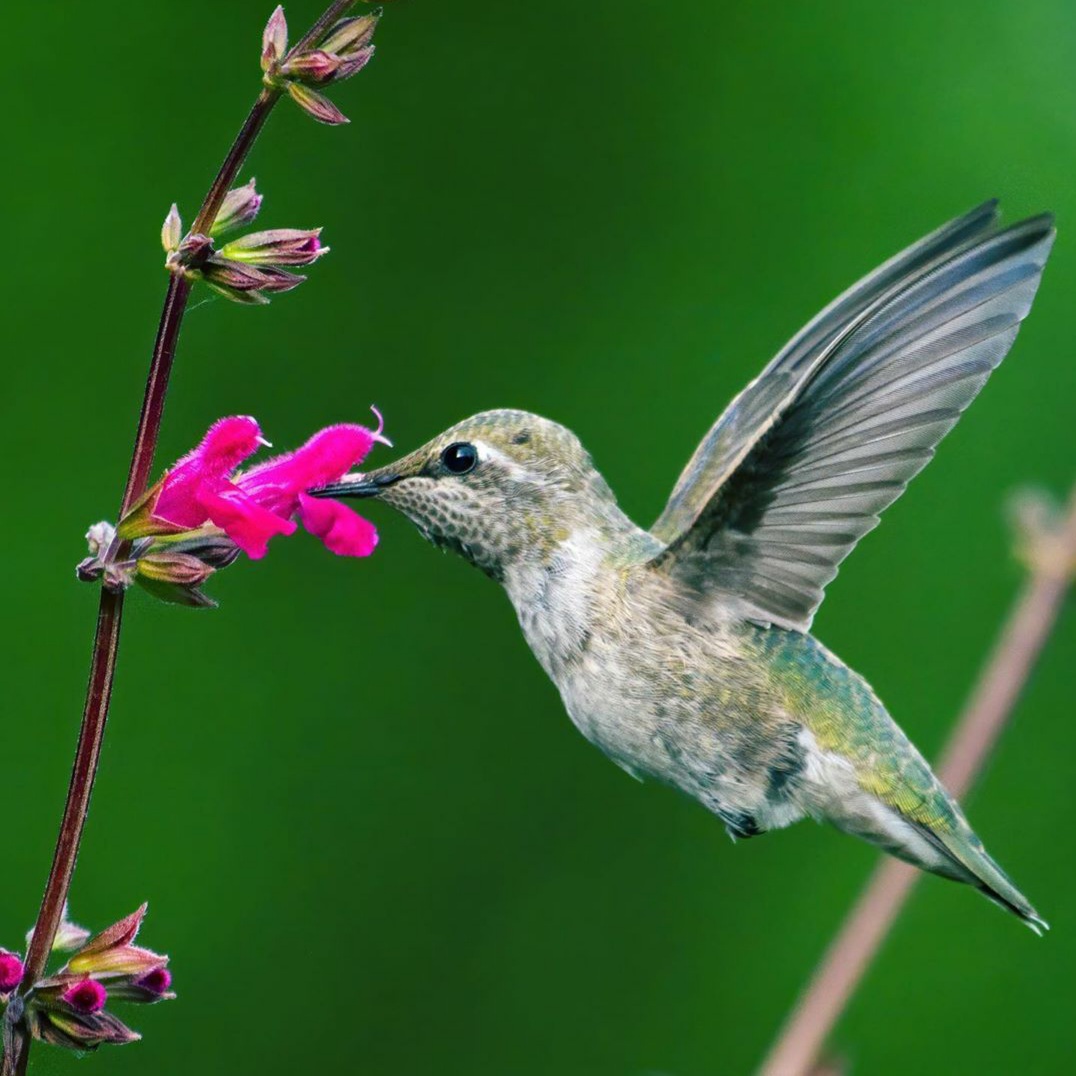This post contains affiliate links.
What types of hummingbirds are found in Oregon?
There are 9 species of hummingbirds found in Oregon:
- Allen’s Hummingbirds (Selasphorus sasin)
- Anna’s Hummingbirds (Calypte anna)
- Black-chinned Hummingbirds (Archilochus alexandri)
- Broad-billed Hummingbirds (Cynanthus latirostris)
- Broad-tailed Hummingbirds (Selasphorus platycercus)
- Calliope Hummingbirds (Selasphorus calliope)
- Costa’s Hummingbirds (Calypte costae)
- Rufous Hummingbirds (Selasphorus rufus)
- Ruby-throated Hummingbirds (Archilochus colubris)
Sighting Maps:
These 9 species of hummingbirds are documented as being seen in Oregon by sighting maps:
(click links to see sighting map)
- Allen’s Hummingbirds (Selasphorus sasin)
- Anna’s Hummingbirds (Calypte anna)
- Black-chinned Hummingbirds (Archilochus alexandri)
- Broad-billed Hummingbirds (Cynanthus latirostris)
- Broad-tailed Hummingbirds (Selasphorus platycercus)
- Calliope Hummingbirds (Selasphorus calliope)
- Costa’s Hummingbirds (Calypte costae)
- Rufous Hummingbirds (Selasphorus rufus)
- Ruby-throated Hummingbirds (Archilochus colubris)
According to the United States Department of Agriculture, Rufous hummingbirds are the most common and widespread species of hummingbird to be seen even though Anna’s hummingbirds are the only species that live in Oregon year-round.
These 9 hummingbird species found in Oregon are further categorized into 3 groups:
Residents (Year-Round) Hummingbirds – these are hummingbirds that live full-time in Oregon and do not migrate.
Seasonal Hummingbirds – these are migratory hummingbirds. Some are only passing through Oregon on their way north in the spring migration or south in the fall migration. Some will remain in Oregon all summer long but migrate south in the winter. Some seasonal hummingbirds will remain in Oregon for the entire winter by choice, injury, or old age.
Vagrant (Rare) Hummingbirds – these hummingbirds are out of their normal area of occupancy but have been documented as being seen in Oregon.
Oregon, known as the Beaver State, is located in the Pacific Northwest along the West Coast between Washington on the northern border and California on the southern border. Oregon features temperate conditions with thick evergreen mountainous forests.
Western Oregon features an oceanic climate with warm summers and rainy winters while Eastern Oregon provides a drier desert climate. The weather conditions along the coast change constantly and have frequent overcast cloud covers which are perfect for hummingbird communities to thrive and flourish.
Categories of Hummingbirds:
Year-round/Native Hummingbirds:
This hummingbird classification is defined as hummingbirds residing in Oregon 365 days a year and do not migrate.
- Anna’s Hummingbirds
Anna’s hummingbirds have been documented sightings in the western half of Oregon from Washington to the California border.
Other spotty sightings are documented in Spokane, Flathead National Forest, Missoula, Nez Perce Reservation, Payette National Forest, and the Kennewick area.
Anna’s hummingbirds are the only species that are year-round residents staying 365 days out of the year in Oregon.
Seasonal Hummingbirds
This hummingbird classification is defined as hummingbirds in Oregon temporarily as part of their migratory pattern. Some of each of these species spend the entire spring, summer, and fall in Oregon while others of this migratory group may travel to more northern states during the summer.
- Allen’s Hummingbirds (Selasphorus sasin)
- Black-chinned Hummingbirds (Archilochus alexandri)
- Broad-tailed Hummingbirds (Selasphorus platycercus)
- Calliope Hummingbirds (Selasphorus calliope)
- Costa’s Hummingbirds (Calypte costae)
- Rufous Hummingbirds (Selasphorus rufus)
Allen’s hummingbirds have documented sightings throughout the McDonald-Dunn Forest as far north as Kings Valley, south as far as Greenberry, east as far as Lewisburg and Kiger Island, as far west as Wren.
Allen’s also have sightings along the coast from the Randolph/Coquille south to the California border; further inland seen in an area from Illahe/Agness extending into the Rogue River-Siskiyou National Forest/Kalmiopsis Wilderness area and continuing to the California border.
The area from Glendale to Merlin just west of Interstate 5 also has documented sightings of Allen’s hummingbirds.
Black-chinned hummingbirds have documented sightings concentrated in the northeast quarter of Oregon and spotty sightings in the southern and western half of Oregon.
There is a noticeably decrease in sightings along the coast of Oregon.
Broad-tailed hummingbirds have limited sighting in Oregon but there have been documented sightings in Wallowa-Whitman National Forest, in Umatilla National Forest, and surrounding cities of Pendleton/La Grande/Baker city, Siuslaw National Forest and nearby Albany, Fremont National Forest, and nearby cities of Klamath Falls/Lakeview/Paisley/Summer Lake areas, and cities of Merrill, Klamath Falls, Chiloquin, and Fort Klamath.
Calliope hummingbirds have documented sightings in the middle half of Oregon from the border of Washington to California.
There is a noticeably decrease in sightings along the coast of Oregon.
Costa’s hummingbirds are a rare sighting in the eastern half of Oregon but have documented sightings in and around the cities of Rockaway Beach, Portland, and surrounding cities of Hillsboro/Beaverton/Gresham/Vancouver, Newport/Toledo/Waldport, Florence/Mapleton, Eugene, Bend, Burns, Oakridge, Winchester Bay/North Bend/Coos Bay, Sutherlin to Canyonville, Silver Lake, Klamath to Merrill, Eagle Point/White City/ Eagle Point, Grants Pass, Langlois to Port Orford, and Brookings.
Rufous hummingbirds have been documented sightings throughout the entire state of Oregon with the densest sighting in the western half of the state.
Rare/Vagrant Hummingbirds
This hummingbird classification is defined as hummingbirds residing in a group outside of their normal geographic range. Not only do these species of hummingbirds have a wide variety of specific geographic ranges, but they are also known to sometimes interbreed with each other creating hybrids.
- Broad-billed Hummingbird
- Ruby-throated Hummingbird
Broad-billed hummingbirds may be the rarest hummingbird documented as being seen in Oregon.
Sightings have been documented in the northern area of Malheur National Forest in the area of John Day and Canyon City.
Also, documented sightings are west of Highway 78 from Lawen to Malheur National Wildlife Refuge.
Ruby-throated hummingbirds are a rare hummingbird that is documented as being seen in Oregon.
Sightings have been documented in an area north of Pendleton southward to Piolet Rock, east of Valley Falls, and in cities around Bear Valley National Wildlife Refuse of Fairhaven/Midland/Keno/Worden.
Read on to find out more about each of these hummingbird species.
Year-round/Native Hummingbirds
ANNA’S HUMMINGBIRD – (Calypte anna)
Conservation Status: Least concerned
Kingdom: Animalia
Phylum: Chordata
Class: Aves
Order: Apodiformes
Family: Trochilidae
Genus: Calypte
Species: C. anna
Anna’s hummingbirds are named after Anna Massena, Duchess of Rivoli. Anna’s hummingbirds are the only hummingbirds to stay year-round on the Pacific Coast in Oregon and are winter native habitats. They are commonly seen in Portland.
According to the Oregon Department of Fish and Wildlife, Anna’s hummingbirds are the only species found in Oregon throughout the winter. They expose themselves to shorter days with limited food sources and intense cold winters.
Anna’s hummingbirds are the only hummingbird species in North America with a red crown. They are identified as mostly green, gray, and magenta in color. The males have a flashier, more colorful iridescent magenta gorget and crown. Their size ranges from 3.5 inches to 4.3 inches in length.
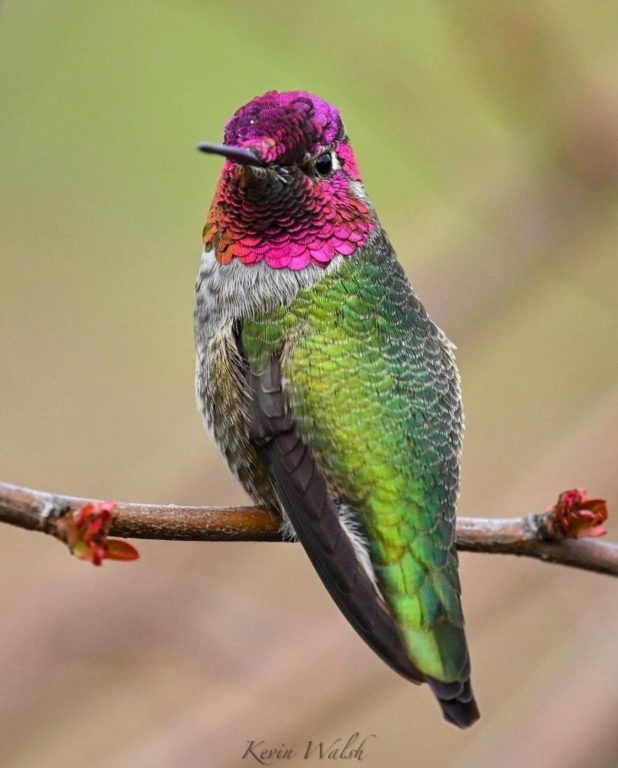
Photo by: Kevin Walsh
Taken: Oregon
Note: The iridescent magenta gorget and crown with a metallic green shiny back.
The gorget of a hummingbird is named after the protective metal piece in a suit of armor that covers the wearer’s throat to prevent injury when in battle. Since male hummingbirds are very aggressive with each other when fighting for their own territory, this name is appropriate and fitting to describe their physical attributes.
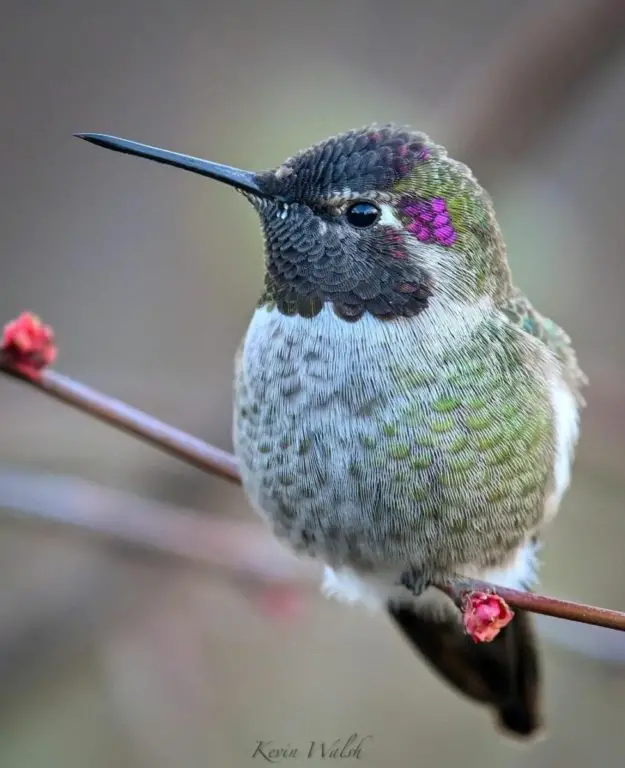
Photo by: Kevin Walsh
Taken: Oregon
Note: This juvenile male Anna’s hummingbird is beginning to show his magenta head feathers near his temple along with some faint color starting to show on his gorget.
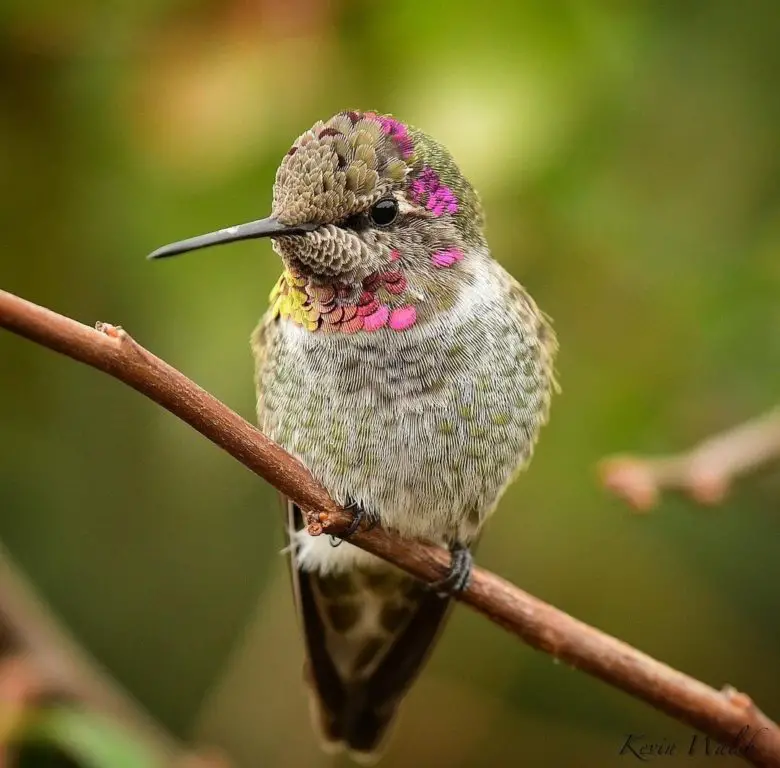
Photo by: Kevin Walsh
Taken: Grants Pass, Oregon
Note: This Anna’s hummingbird could be a juvenile in those awkward teenage years or it could be during a molting stage.
Female Anna’s hummingbirds can also have a gorget, but it is a smaller patch of magenta. The females are overall not as colorful as the males and are a paler color of green. Females tend to have a pale white line over each eye that makes them distinctive.
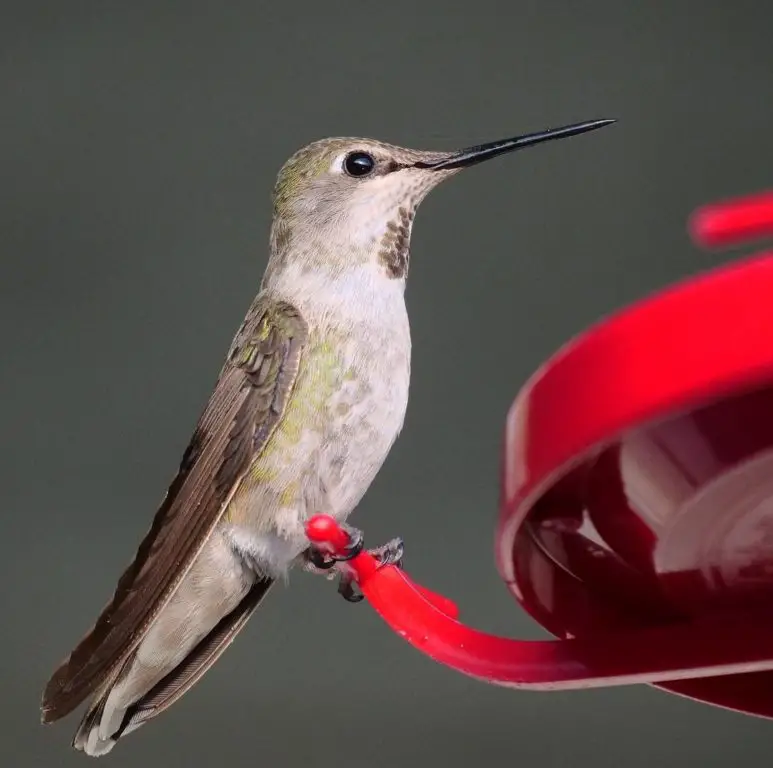
Photo by: Kevin Walsh
Taken: Oregon
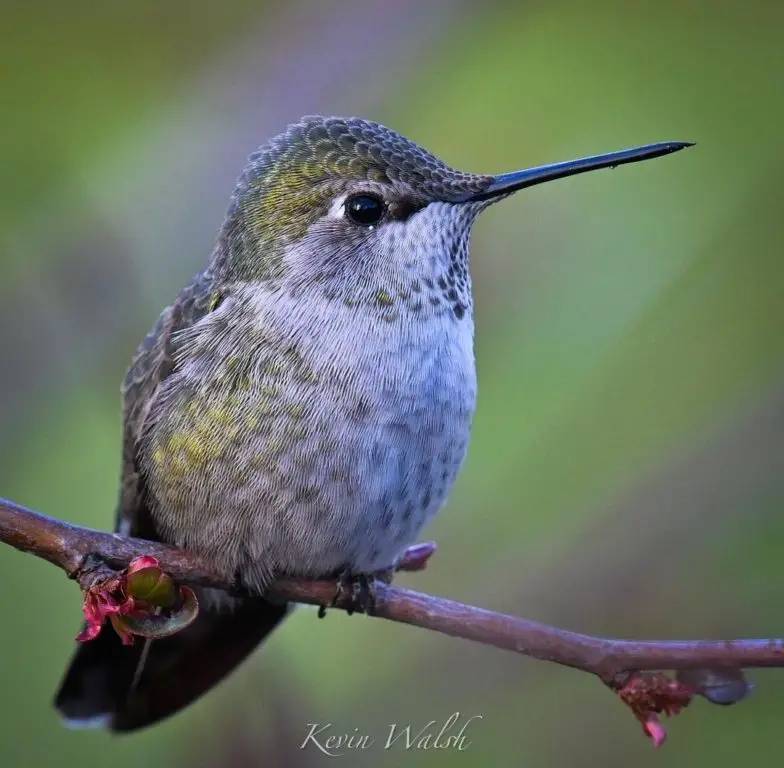
Photo by: Kevin Walsh
Taken: Oregon
Unlike many northern temperate hummingbirds, male Anna’s hummingbirds sing during courtship along with making vibrations with their tail feathers.
Anna’s hummingbirds nest regularly in the Willamette Valley (stretching 150-miles long) bordering the Cascade Range and also along the coast of Oregon. Willamette Valley is 47 miles south of Portland.
Anna’s hummingbirds live in a Mediterranean climate with moderate wet winters and hot dry summers. Their habitat has expanded to Oregon’s local residential gardens, parks, and coastal valleys which in turn provides access to an abundant food supply of nectar-producing flowering plants and hummingbird feeders all year-round.
Anna’s hummingbirds hybridize, cross-breeding readily with the Black-chinned hummingbirds.
See pictures of male, female and juvenile Anna’s hummingbirds here…..
Hear sounds of Anna’s hummingbirds here…..
Seasonal Hummingbirds
RUFOUS HUMMINGBIRD – (Selasphorus rufus)
Conservation Status: Near threatened
Kingdom: Animalia
Phylum: Chordata
Class: Aves
Order: Apodiformes
Family: Trochilidae
Genus: Selasphorus
Species: S. rufous
The Rufous hummingbird acquires its name from the Latin word rubrum meaning “red” describing its reddish-brown coloring.
Rufous hummingbirds and Anna’s hummingbirds are commonly seen in Oregon; however, there is an abundance of Rufous hummingbirds in central Oregon compared to Portland.
Male Rufous hummingbirds display an iridescent orange-red gorget, however, in darker lighting it can appear chocolate brown. Their flanks and tail are rusty in color. They have a white to beige underbelly and a black bill. Males can also have green plumage with specks of green color on their rustic-looking backs or on the crown of their head along with chocolate brown dorsal feathers. Their size is 2.8 inches to 3.5 inches in length and weighs 3.2 grams.
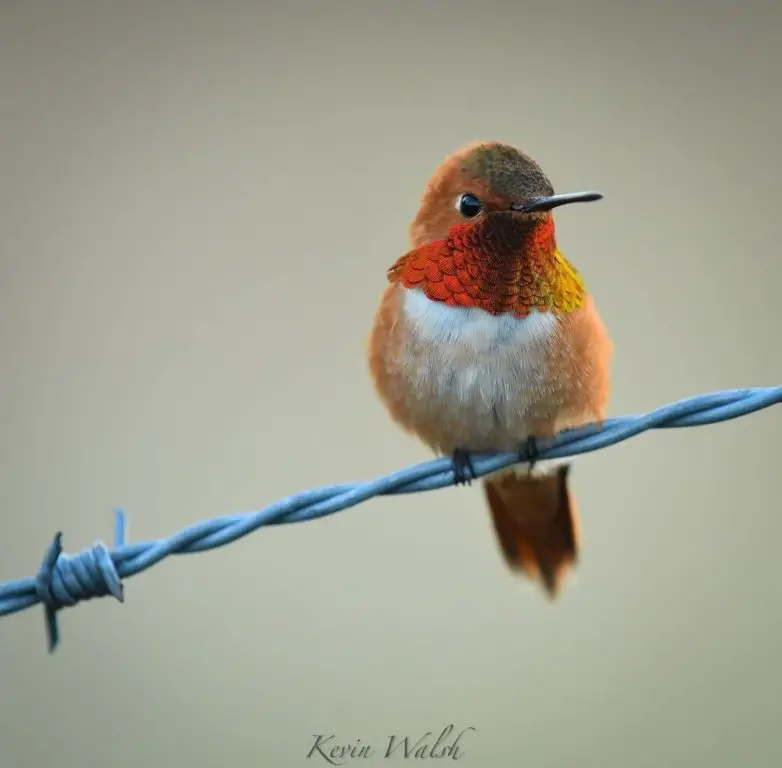
Photo by: Kevin Walsh
Taken: Grants Pass, Oregon
Note: The iridescent orange-red gorget.
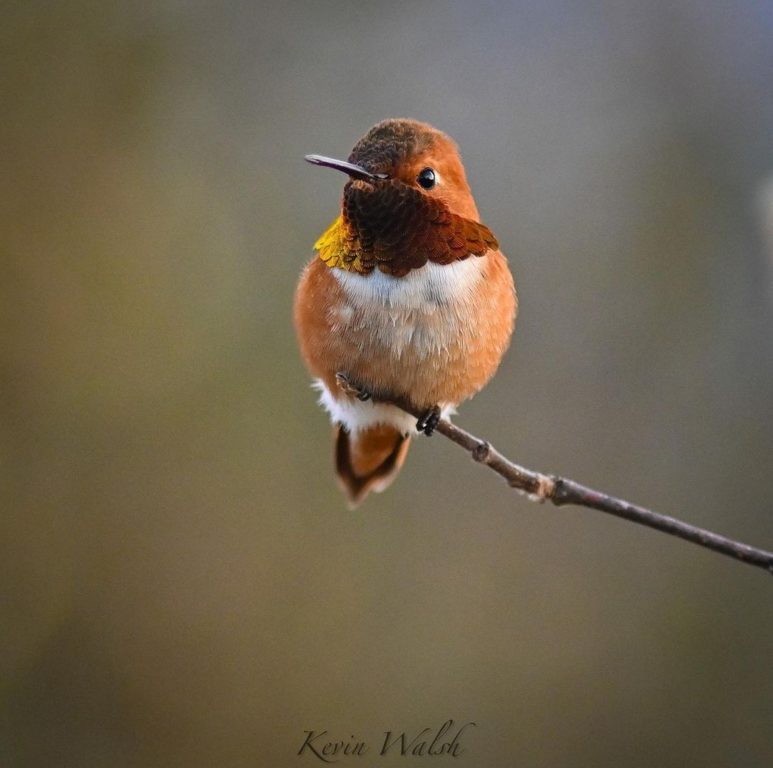
Photo by: Kevin Walsh
Taken: Grants Pass, Oregon
Note: The gorget appears chocolate brown in this lighting, however, you can still see a glimmer of his iridescent orange-red gorget with some hints of yellow.
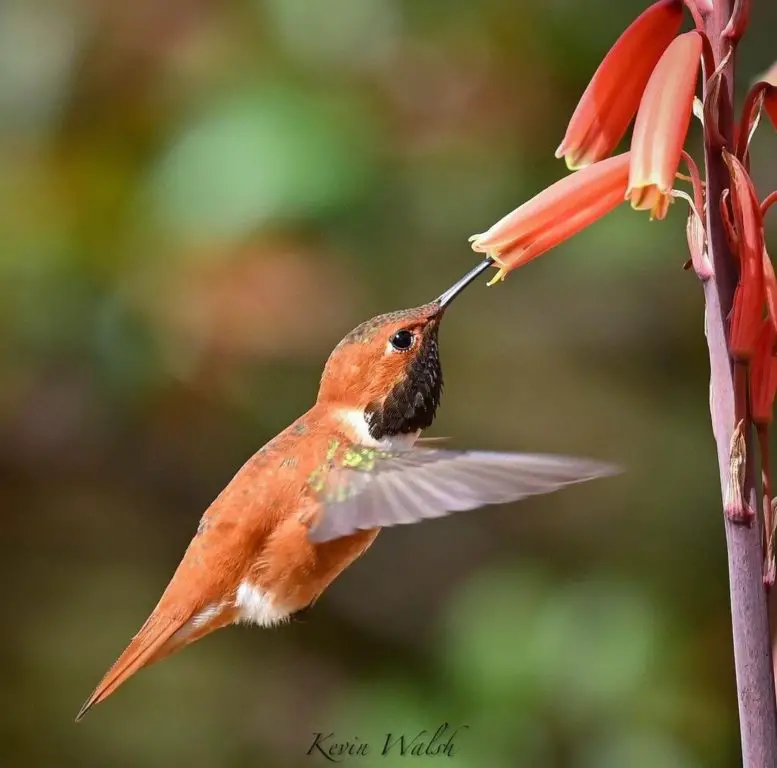
Photo by: Kevin Walsh
Taken: Grants Pass, Oregon
Plant: Blue Elf Aloe
Juvenile male Rufous hummingbirds have a rustic look with small iridescent orange specks of color on their throats.
Juvenile Rufous hummingbirds are so similar in coloring and temperament to an Allen’s hummingbird that they are practically indistinguishable in the field. Therefore, identification is established by range rather than appearance.
Female Rufous hummingbirds are green and white with some iridescent orange feathers on their throat. Their tail is dark with white tips and an orange-red base. Female Rufous hummingbirds are slightly larger than the males in anticipation of producing offspring.
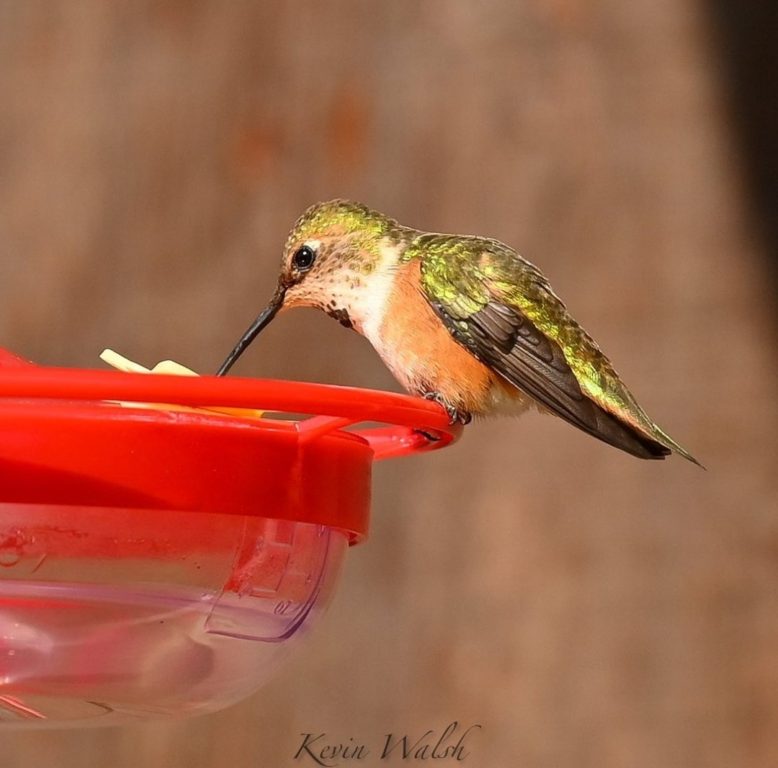
Photo by: Kevin Walsh
Taken: Grants Pass, Oregon
As a migratory and seasonal bird, Rufous hummingbirds are seen from March to September. Their peak migration happens in the months of March and April. They begin their fall migration in June.
Rufous hummingbirds travel the longest annual migration of any bird in the world expanding a distance of approximately 3,900 miles. They spend their winters in southern California, Mexico, and Central America; migrate up the northern Pacific Coast in the spring (to nest), and fly south in the fall along the Rocky Mountains; heading back to their winter grounds again making a clockwise oblong or oval migration circuit.
This migratory pattern during the seasons coordinates their arrival perfectly while catching nectar and blooming flowers throughout the year, fueling their bodies for their long journey.
Rufous hummingbirds breed during April and are found nesting in the mountains, west of the Cascades. They begin to leave their breeding grounds in June and July. They have one of the northernmost breeding ranges of any hummingbird in the world, nesting as far north as Alaska. Rufous hummingbirds are polygamous and will mate with several partners in a season.
The females and juvenile Rufous hummingbirds mostly migrate in August, but are documented beginning their migration south between July through September.
Rufous hummingbirds are highly territorial and are aggressive towards other hummingbirds and animals. They have been known to even attack squirrels and chipmunks that come too close to their nest. They can outmaneuver all other hummingbirds in the air, making them extremely competitive at feeders.
Rufous hummingbirds have excellent memories and have been known to investigate the location of an old hummingbird feeder years after the feeder has been removed.
During a capture and release banding operation in British Columbia, the oldest living recorded female Rufous hummingbird was 8 years and 11 months old.
See my article: 3 Reasons Why Hummingbirds Are Banded
Due to habitat loss in the Pacific Northwest, Rufous hummingbirds are listed at “near threatened” status by the IUCN red list of threatened species.
See pictures of male, female and juvenile Rufous hummingbirds here…..
Hear sounds of Rufous hummingbirds here…..
ALLEN’S HUMMINGBIRD – (Selasphorus sasin)
Conservation Status: Least concerned
Kingdom: Animalia
Phylum: Chordata
Class: Aves
Order: Apodiformes
Family: Trochilidae
Genus: Selasphorus
Species: S. sasin
The common name of Allen’s hummingbird is in commemoration of Charles Andrew Allen (1841-1930), an American collector and taxidermist.
These common residents are sighted in the spring and summer along the southern Oregon coast. They are often discovered in urban residential areas sipping nectar from feeders in Curry County. Curry County resides in the southwestern corner of Oregon, west of Medford, touching the California border.
Male Allen’s hummingbirds show an iridescent orange-red gorget. They are green-backed with a green forehead and rust-colored flanks, rump, and tail. When their tail feathers are fanned out you can see their chocolate-colored tips. Allen’s hummingbirds are 3.3 inches to 3.5 inches in length.
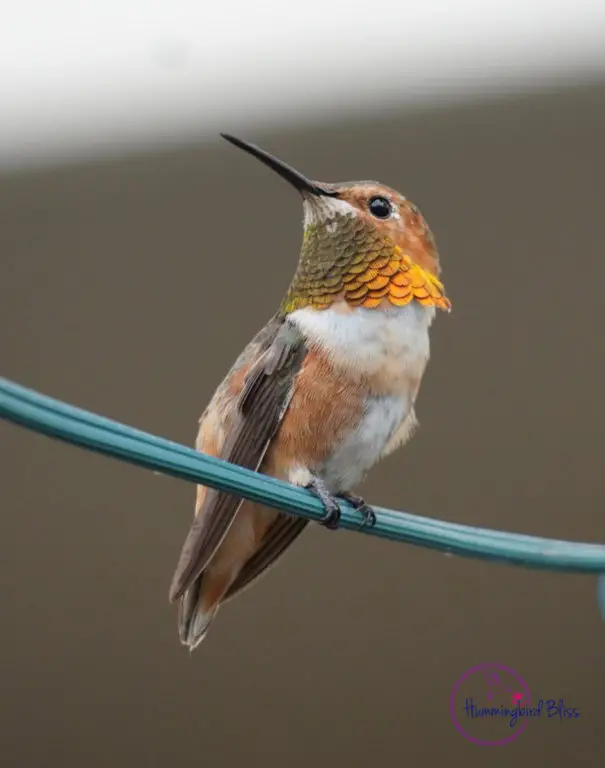
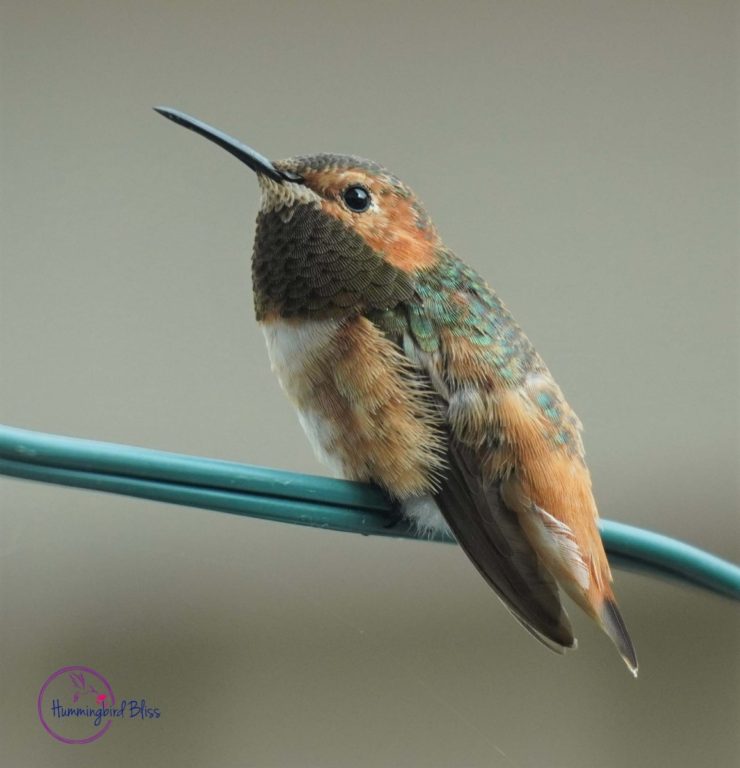
Note: The gorget appears chocolate brown in this lighting; however, this is the same adult male Allen’s hummingbird featured in the above picture.
Female and juvenile Allen’s hummingbirds have similar coloring as the males, but do not have an iridescent gorget.
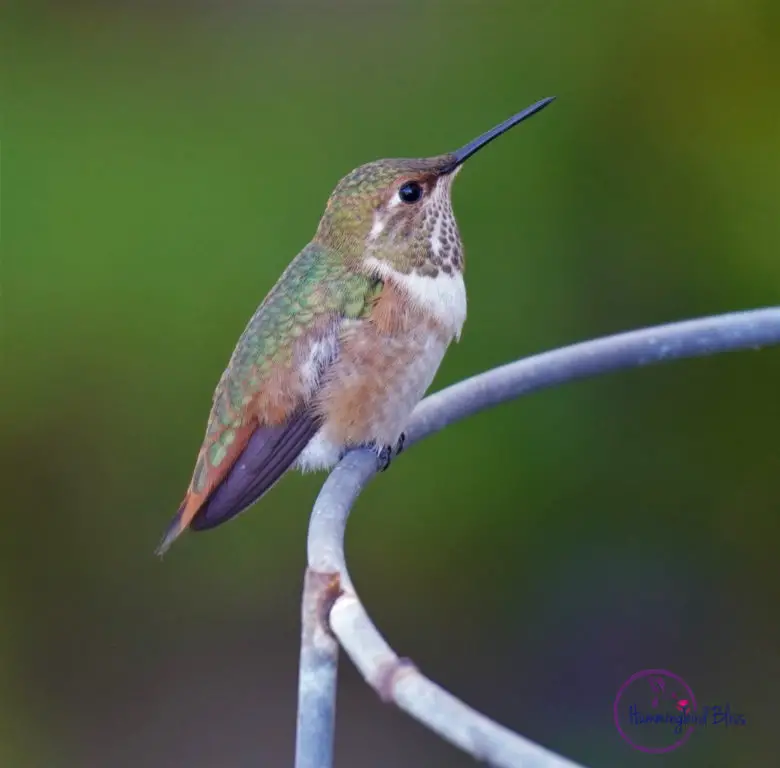
Note: On a tomato cage defending a feeder.
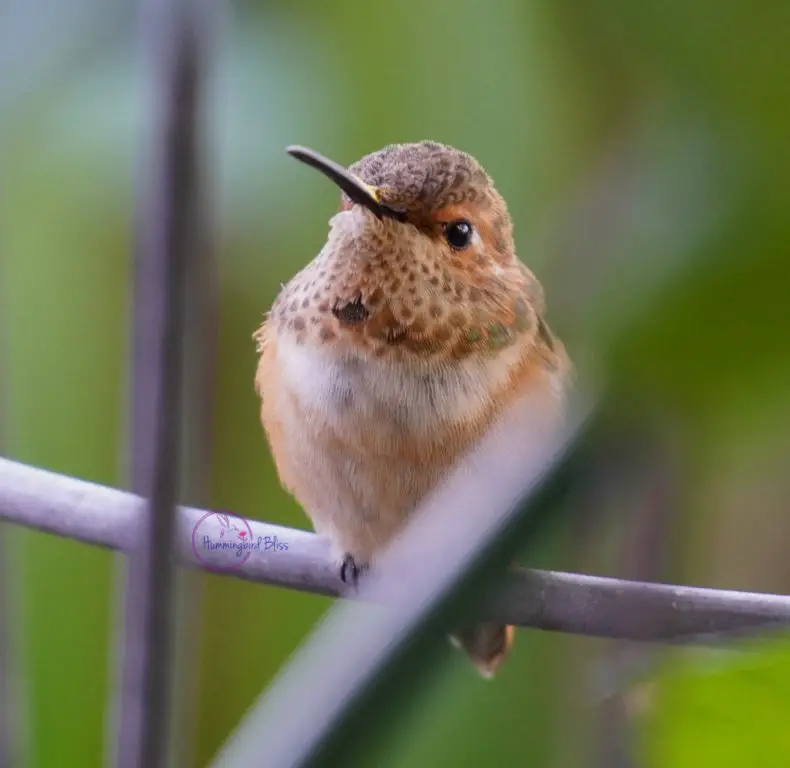
Note: On a tomato cage and hiding in a tomato plant near a feeder.
Juvenile Allen’s hummingbirds are so similar in coloring and temperament to a Rufous hummingbird that they are practically indistinguishable in the field. Therefore, identification is established by range rather than appearance.
Male Allen’s hummingbirds perform a striking, quick back-and-forth courtship dance resembling the movement of a pendulum. They have one of the most complex territorial dive displays of any North American hummingbird.
See my article: Hummingbird Dance: 5 Interpretive Explanations…..
Allen’s hummingbirds breed in the coastal marine layer of southern Oregon. They are similar to Rufous hummingbirds, traveling south to winter in Mexico.
Their habitat consists of open woodlands, riparian wetlands, and dry chaparral vegetation of dense shrubs/thorny bushes.
Allen’s hummingbirds are absent in mountainous elevations above 9,000 feet due to the lack of hummingbird flowers that would otherwise serve as their nectar source.
Male and female Allen’s hummingbirds are not social birds. They do not associate with one another outside of breeding. Similar to a Rufous hummingbird, Allen’s hummingbirds are highly territorial and aggressive towards other hummingbirds and larger predatory birds such as hawks.
See pictures of male, female and juvenile Allen’s hummingbirds here…..
Hear sounds of Allen’s hummingbirds here…..
CALLIOPE HUMMINGBIRD – (Selasphorus calliope)
Conservation Status: Least concerned
Kingdom: Animalia
Phylum: Chordata
Class: Aves
Order: Apodiformes
Family: Trochilidae
Genus: Selasphorus
Species: S. calliope
Calliope hummingbirds are named after a Greek mythological muse who represented poetry and eloquence. Calliope means “beautiful voice” in ancient Greek. Calliope hummingbirds are seasonal migrants found in Oregon between April through September.
Calliope hummingbirds are the smallest long-distance migratory bird in the world. Their migratory patterns mimic Rufous hummingbirds with spring migration and these hummingbirds are known to travel through Crater Lake National Park.
They arrive in April or May and begin nesting in June. The rest of their time is spent traveling south or east in September for the winter.
Male Calliope hummingbirds are easily identified by their iridescent purple crown and long striking spaced outline row of feathers that project down the sides of their throats. Their backs are, like many hummingbirds, metallic green. Their size measures 3 inches in length.
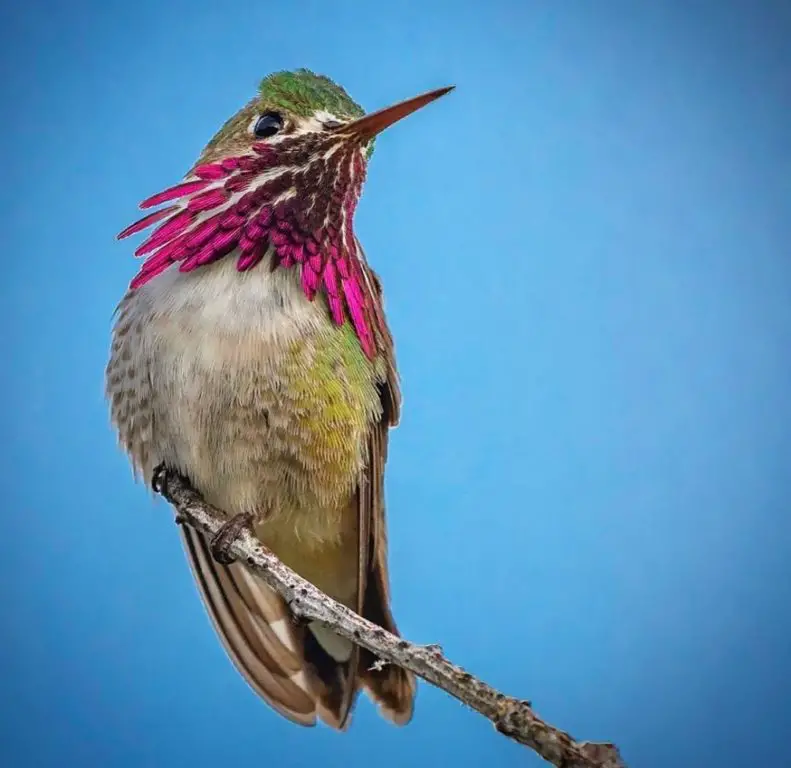
Photo by: sony_alpha_male
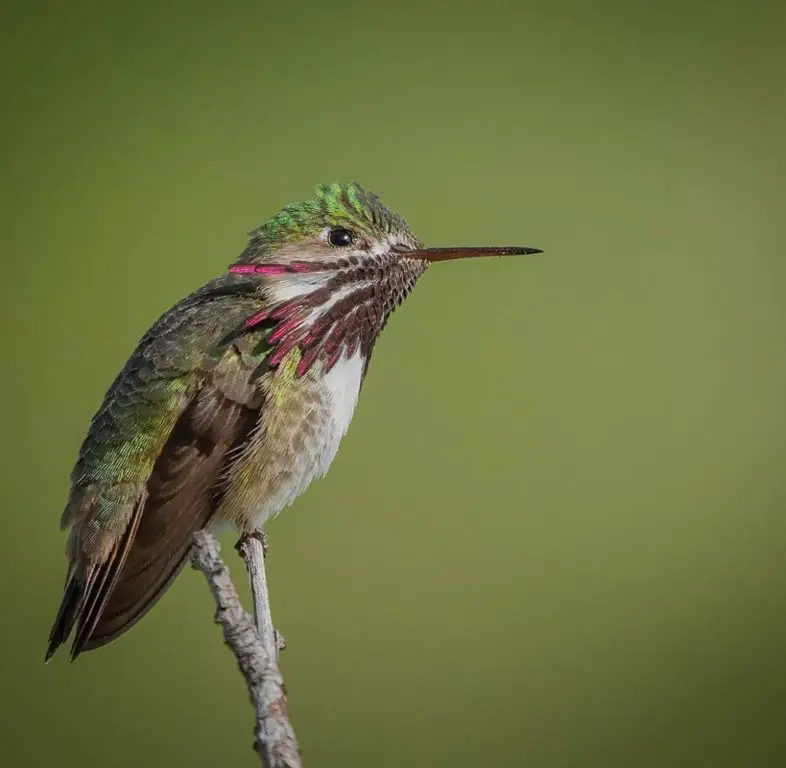
Photo by: sony_alpha_male
Note: His bright gorget feathers are slowly coming in.
Female Calliope hummingbirds have gray-green crowns and buff-colored flanks which are the underbelly or wing of a bird. Females sport dark tails with white tips.
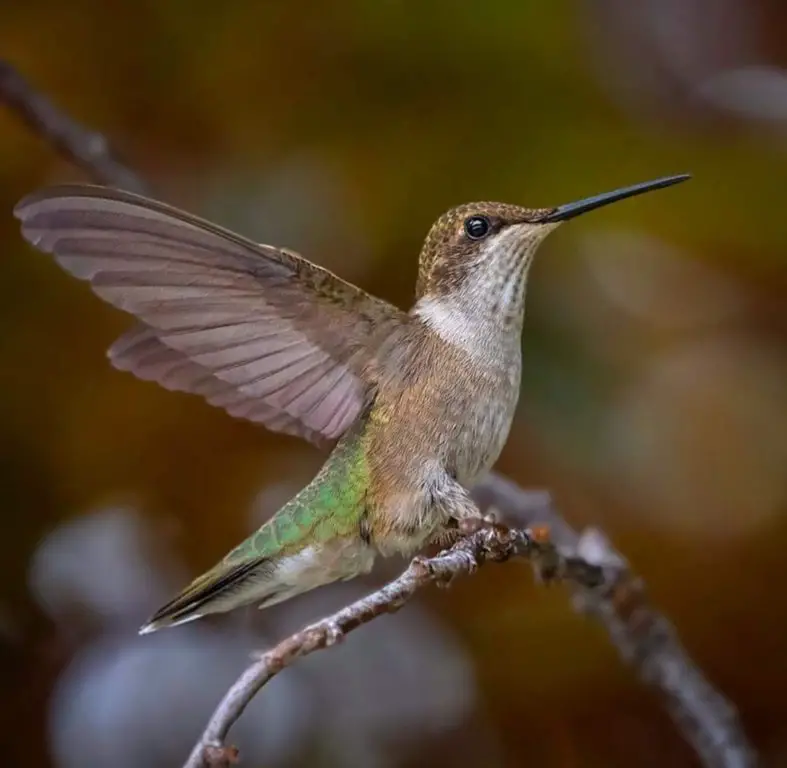
Photo by: sony_alpha_male
Like many hummingbirds, Calliopes communicate not just by their song, but also by manipulating their feathers during flight to make different buzzing noises that act as a form of language and communication.
When a female is quietly perched, the male will passionately fly back and forth and engage in a “U” shaped courtship display to gain her attention. During his presentation, the male hummingbird will produce a vocal serenade while swinging his body from side to side in front of the female.
See my article: Hummingbird Dance: 5 Interpretive Explanations…..
Male Calliope hummingbirds establish a breeding territory and mate with every available female hummingbird that accepts his courtship.
They are known to nest in the Blue and Wallowa Mountains of Oregon. Both mountain ranges are located in the northeastern corner of Oregon close to the Washington and Idaho borders. These two areas are approximately 39 miles apart or a 41-minute drive.
The Cascade Range that extends through Oregon is also known for Calliope hummingbird nests.
When a female Calliope hummingbird builds a nest she is known to both nest on the top of pine cones and to steal building materials from the nests of other birds in order to construct her own. She will dismantle nests from previous seasons and recycle them in her new nest.
They are often attacked and chased by larger, more aggressive species of hummingbirds, such as Allen’s and Rufous hummingbirds which causes them to maintain a relatively low profile in comparison to other species.
Because Calliope hummingbirds have a restricted wintering range in comparison to most hummingbirds, they are particularly vulnerable to habitat loss and natural disasters, such as climate change and wildfires. However, Calliope hummingbirds have successfully adapted to colder mountain terrain at higher elevations during the summer nights.
See pictures of male, female and juvenile Calliope hummingbirds here…..
Hear sounds of Calliope hummingbirds here…..
BLACK-CHINNED HUMMINGBIRD – (Archilochus alexandri)
Conservation Status: Least concerned
Kingdom: Animalia
Phylum: Chordata
Class: Aves
Order: Apodiformes
Family: Trochilidae
Genus: Archilochus
Species: A. alexandri
Black-chinned hummingbird’s scientific name is in commemoration of Dr. Alexandre, a French doctor who was the first to discover the species in Mexico.
Being a migratory hummingbird, they are seen between March and September. They are seen in abundance in eastern Oregon during the summer.
Male Black-chinned hummingbirds are identified by their royal purple gorget, showing a small glimmer of color right near the neckline like a buttoned-up shirt. Since the male purple gorget or throat color is minimal, at times they can appear to look all black. They have metallic green on their backs and flanks with white on their underbelly. Their dark tail is forked and their bill is black. Their size is 3.25 inches long.
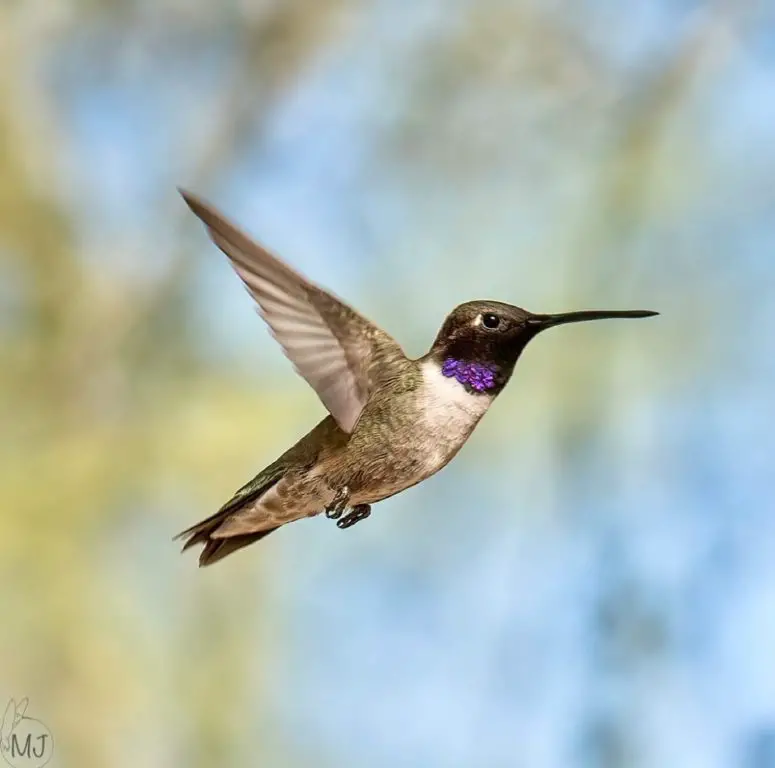
Photo by: hummingbirdsbysuprise
Female and juvenile Black-chinned hummingbirds have no gorget, but have a dark rounded tail with white tips and beige margins on the dorsal feathers that turn dark black as they mature. Their head and back reflect the dull metallic marbled colors of beige, greens, whites, yellow-green, and dark browns, looking similar to the scales found on a snake.
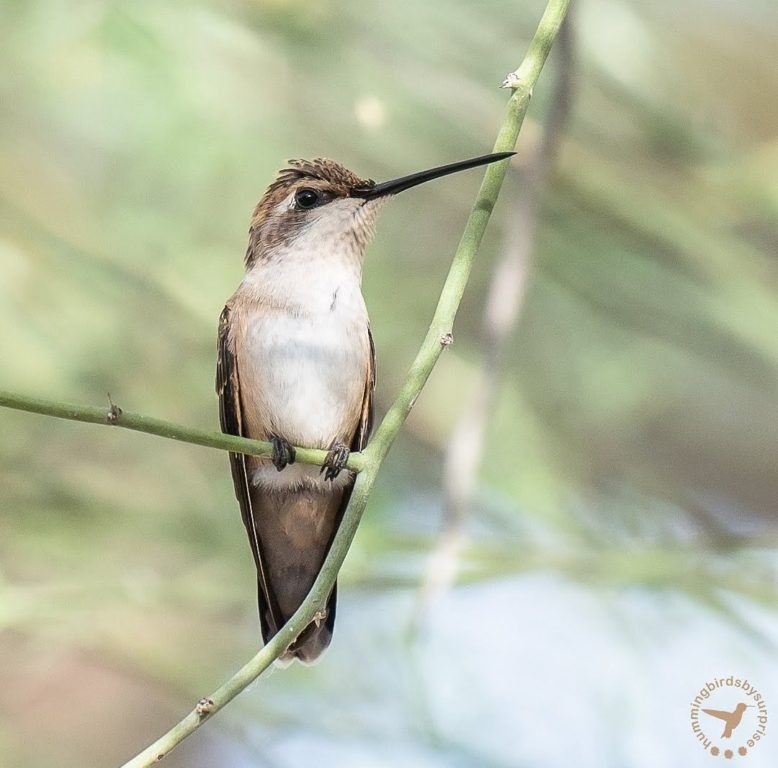
Photo by: hummingbirdsbysuprise
Black-chinned breed east of the Cascade mountain range. They nest in northeastern Oregon.
Their habitat consists of chaparral, woodlands, mountains, and even meadows.
They hybridize and readily crossbreed with other hummingbird species. Black-chinned hummingbirds can live up to 10 years, which is extremely long in comparison to other birds and animals of similar size.
Because of their small size, Black-chinned hummingbirds are at risk of being preyed upon by larger insect-eating birds. Black-chinned hummingbirds are known to make their nests near larger more active bird nests, reducing the chance of predators around the nest by using a decoy strategy.
While typically a territorial species, if Black-chinned hummingbirds find themselves in an area with a large population of hummingbirds and food sources, their territorial behavior reduces and they will play nice and share.
Black-chinned hummingbirds have the smallest known genetic material of all living vertebrates or mammals.
See pictures of male, female and juvenile Black-chinned hummingbirds here…..
Hear sounds of Black-chinned hummingbirds here…..
BROAD-TAILED HUMMINGBIRD – (Selsaphoris platycercus)
Conservation Status: Least concerned
Kingdom: Animalia
Phylum: Chordata
Class: Aves
Order: Apodiformes
Family: Trochilidae
Genus: Selsaphoris
Species: S. platycercus
The Broad-tailed hummingbird, though usually residing in Mexico and as far south as Guatemala during the winter, is a migratory hummingbird found in Oregon. They generally reside in the Rocky Mountains but have been reported in the summers on Oregon’s eastern border.
Sightings map show Broad-tailed hummingbirds have documented Oregon sightings in Wallowa-Whitman National Forest, in Umatilla National Forest, and surrounding cities of Pendleton/La Grande/Baker city, Siuslaw National Forest and nearby Albany, Fremont National Forest, and nearby cities of Klamath Falls/Lakeview/Paisley/Summer Lake areas, and cities of Merrill, Klamath Falls, Chiloquin, and Fort Klamath.
According to the Oregon Department of Fish and Wildlife, there is limited recorded breeding documentation of the Broad-tailed hummingbirds in Oregon since their preferred habitats are isolated.
Male Broad-tailed hummingbirds have an iridescent ruby-red gorget. Both males and females Broad-tailed hummingbirds have green topside and pale underbellies with bright white eye rings and broadly rounded tails. Their size is medium build and ranges from 3.3 inches to 3.8 inches in length and weighs 3.6 grams.
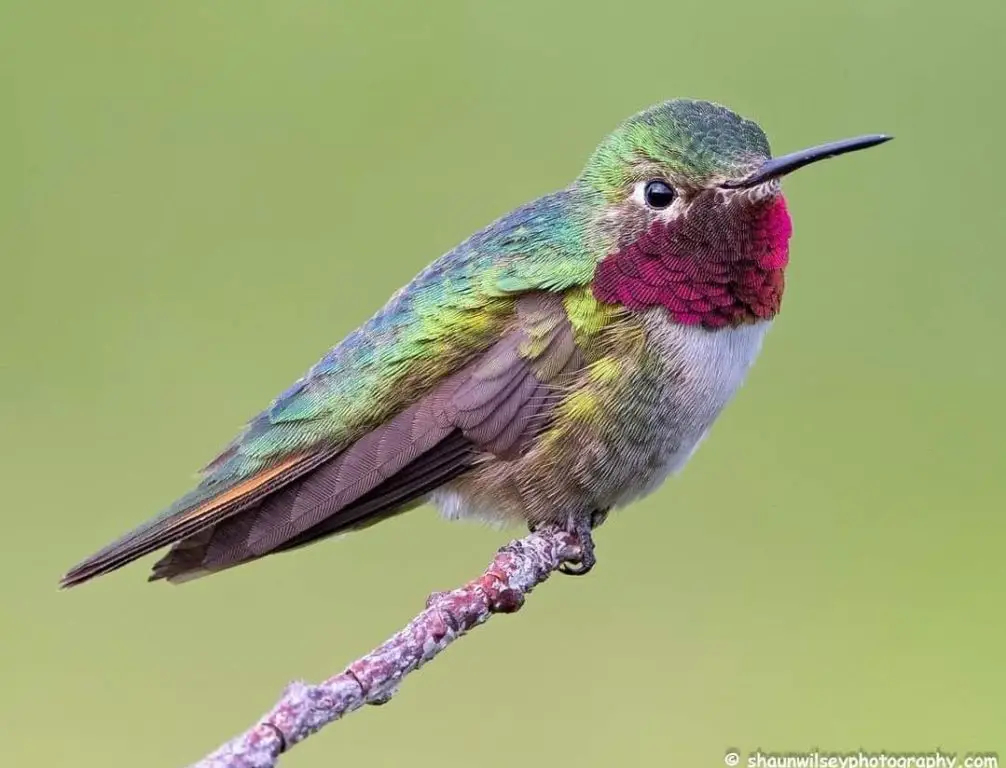
Photo by: shaunwilseyphotography
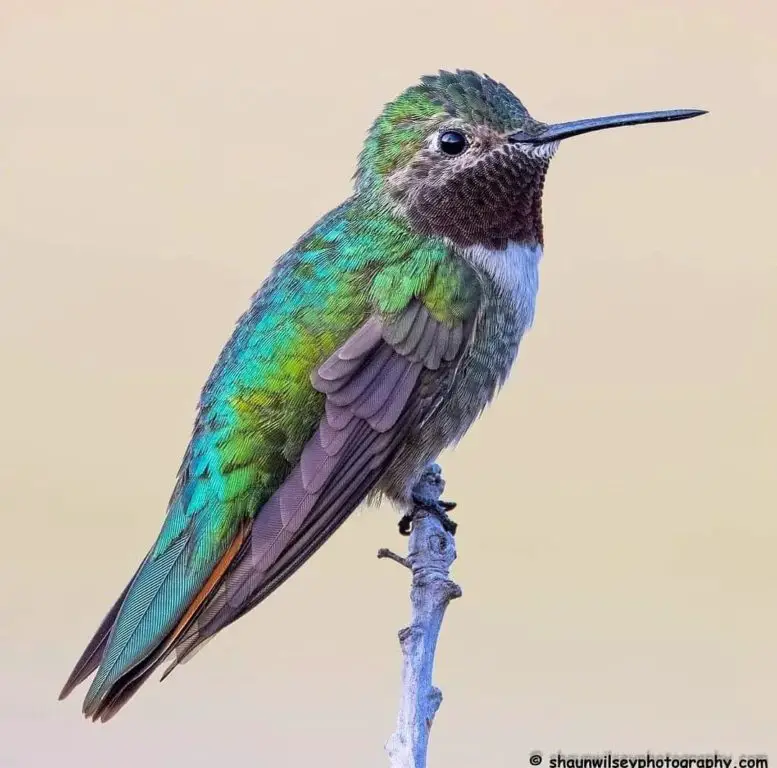
Photo by: shaunwilseyphotography
Note: Male Broad-tailed hummingbirds usually have an iridescent ruby-red gorget, however depending on the lighting their gorget can appear dark in color, as shown above.
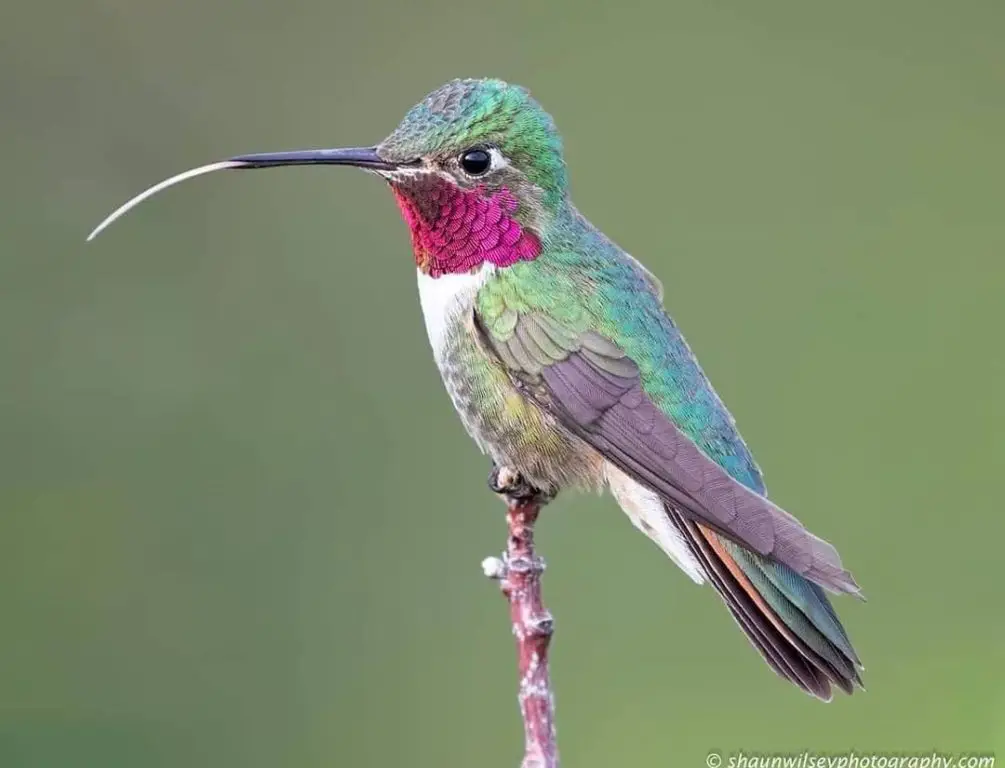
Photo by: shaunwilseyphotography
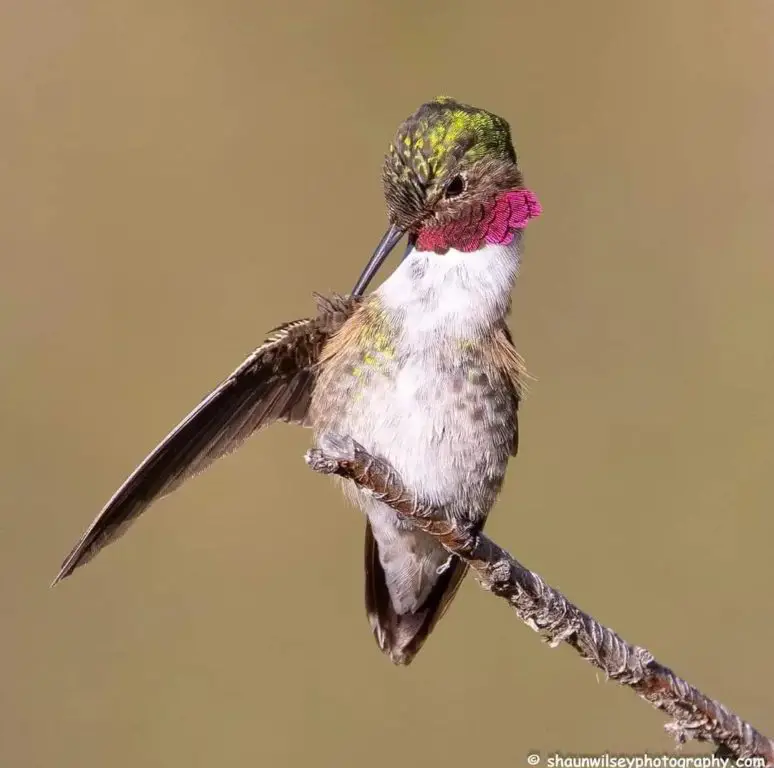
Photo by: shaunwilseyphotography
Note: Preening flight feathers is an important daily routine to maintain hygiene and to keep the feathers flexible, strong, in alignment, and parasite-free.
Female and juvenile Broad-tailed hummingbirds have no gorget, but have green topsides from their head to their tail and pale to beige underbellies with bright white eye rings and broadly rounded tails.
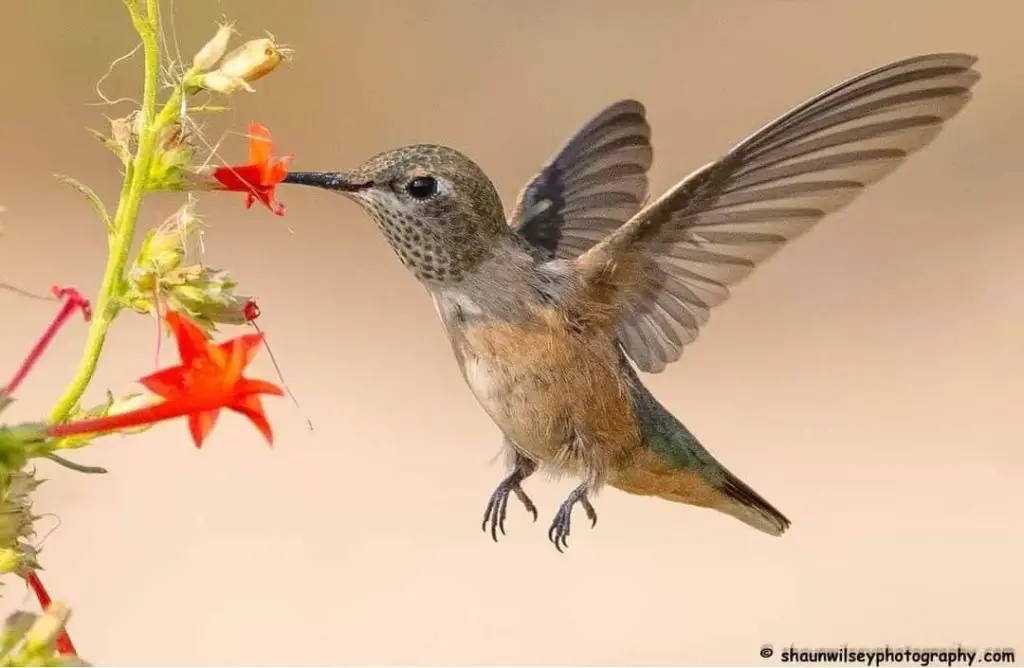
Photo by: shaunwilseyphotography
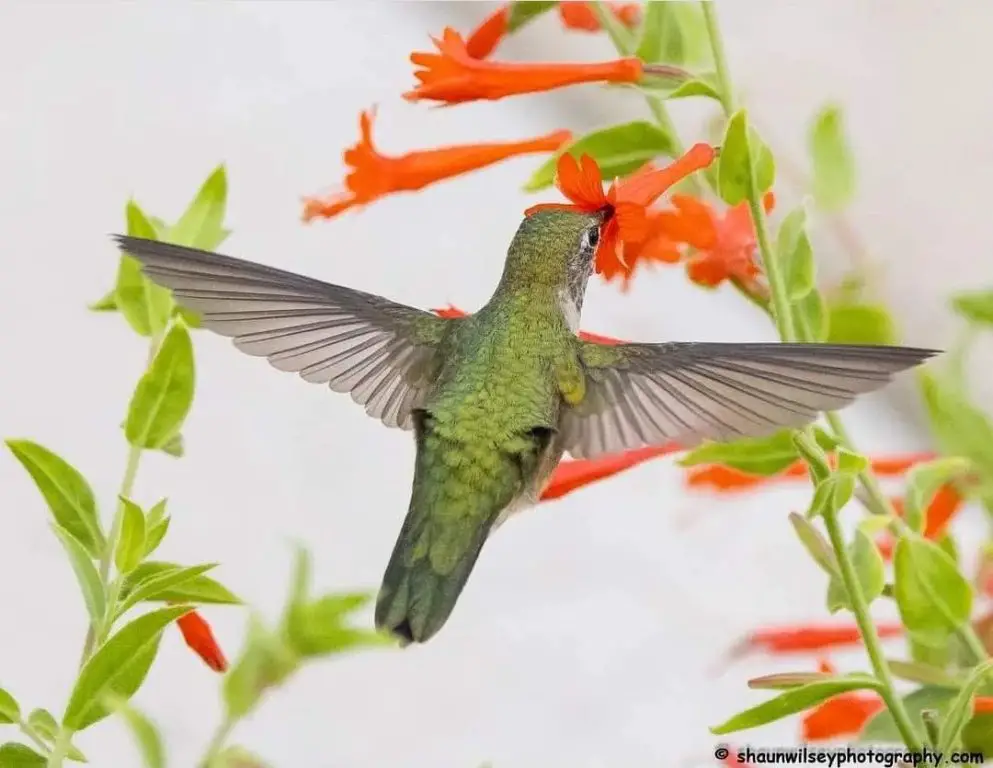
Photo by: shaunwilseyphotography
Note: Hummingbirds beat their wings 80 beats per second. While hovering, the wings move back and forth forming a figure eight or infinity symbol. This powerful movement creates a fanning effect as noticed by the ruffling feathers on both sides of her lower back.
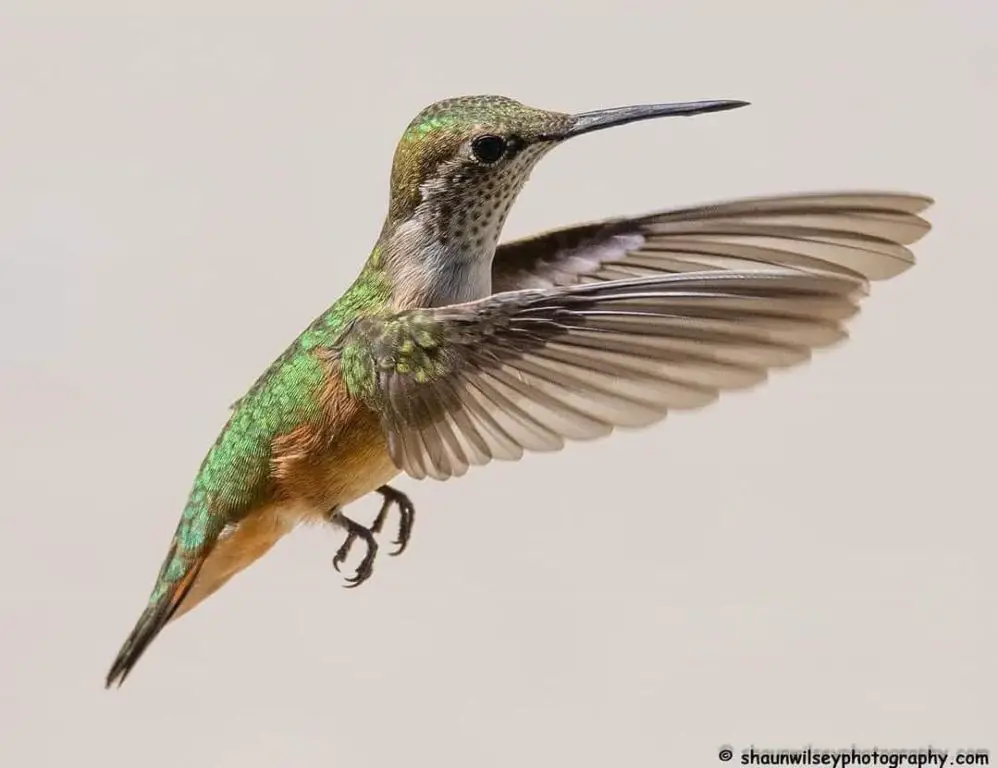
Photo by: sony_alpha_male
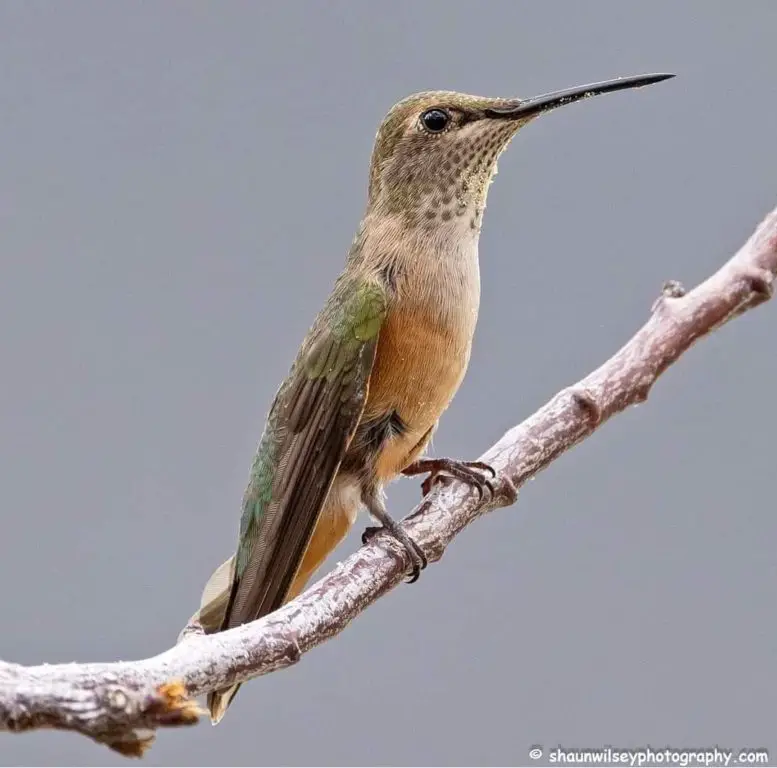
Photo by: shaunwilseyphotography
Note: The thick blanket of pollen on its bill and throat. This juvenile Broad-tailed hummingbird has been busy pollinating and drinking nectar from flowers to sustain its high metabolism.
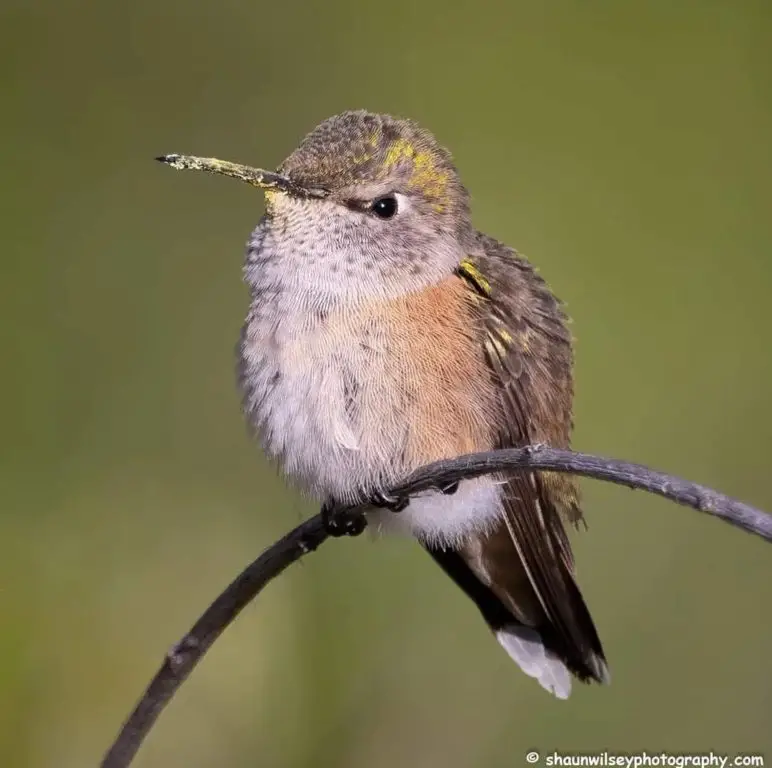
Photo by: shaunwilseyphotography
Note: The newly white fluffy down feathers on this baby/juvenile Broad-tailed hummingbird’s bottom as well as pollen residue on his bill. Also, notice the nice fat reserves they have accumulated by being fed by their diligent mother which will sustain them through adolescence.
This species of hummingbird favors habitats in the understory of mature forest woodlands such as pine and oak groves. They are sometimes found nesting all along Oregon’s eastern border.
They prefer to nest in juniper scrub or coniferous plants including alder, aspen, cottonwood, scrub oak and willow. All of these plants have similar superb material properties for constructing a nest. These birds have been known to return to the same nesting ground each year, roughly 70% of the time. Their breeding time coincides with the peak time of flowering native plants for maximum food resource availability.
They are promiscuous and do not form any kind of a pair bond between the male and female birds. The females raise the young alone.
The Broad-tailed hummingbird has suffered a decline in population since the 1990’s, but presently, its population is stable and it has been shown to have adapted to human habitat encroachment.
See pictures of male, female, and juvenile Broad-tailed hummingbirds here…..
Hear sounds of Broad-tailed hummingbirds here…..
COSTA’S HUMMINGBIRD – (Calypte costae)
Conservation Status: Least concerned
Kingdom: Animalia
Phylum: Chordata
Class: Aves
Order: Apodiformes
Family: Trochilidae
Genus: Calypte
Species: C. costae
The Costa’s hummingbird, though usually residing in Mexico and as far south as Guatemala during the winter, have been documented in Oregon.
Sightings map show Costa’s hummingbirds have documented Oregon sightings in and around the cities of Rockaway Beach, Portland, and surrounding cities of Hillsboro/Beaverton/Gresham/Vancouver, Newport/Toledo/Waldport, Florence/Mapleton, Eugene, Bend, Burns, Oakridge, Winchester Bay/North Bend/Coos Bay, Sutherlin to Canyonville, Silver Lake, Klamath to Merrill, Eagle Point/White City/ Eagle Point, Grants Pass, Langlois to Port Orford, and Brookings.
Costa’s hummingbird was named in 1839 by Jules Bourcier to commemorate Louis Marie Pantaleon Costa, the French ornithologist who was an avid collector of hummingbirds.
Male Costa’s hummingbirds have a bright reddish-purple cap and gorget. Their gorget has long streaming throat feathers, similar to a Calliope hummingbird. Having green backs and flanks, their back and wings are black and their throat and tail have patches of white. Their size ranges from 3 inches to 3.5 inches in length and weighs 2-3 grams.
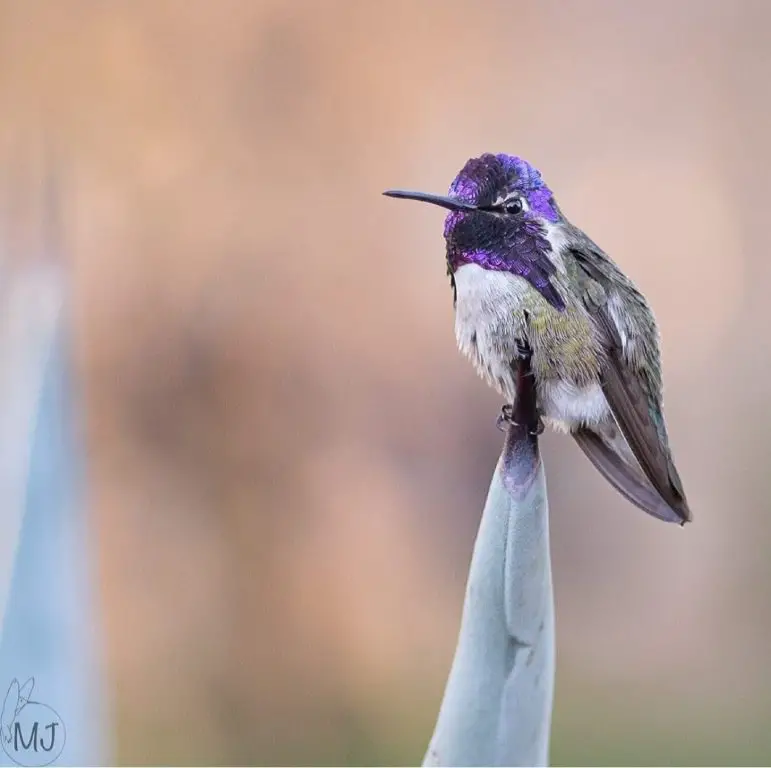
Photo by: hummingbirdsbysuprise
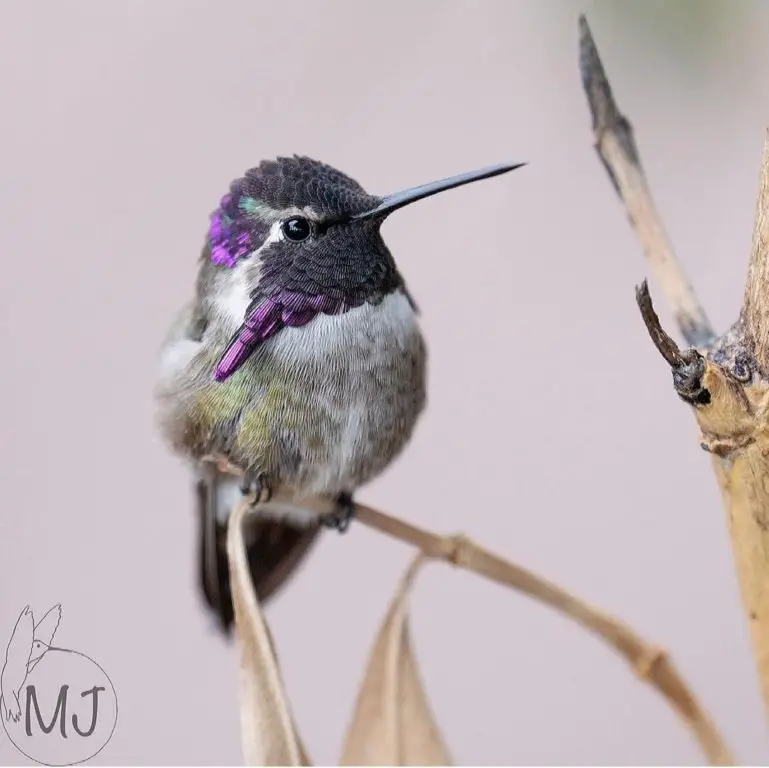
Photo by: hummingbirdsbysuprise
Note: His bright throat feathers are slowly coming in.
Female Costa’s hummingbirds are not as vibrant and display in color, a grayish-light green back with a dusty white underbelly.
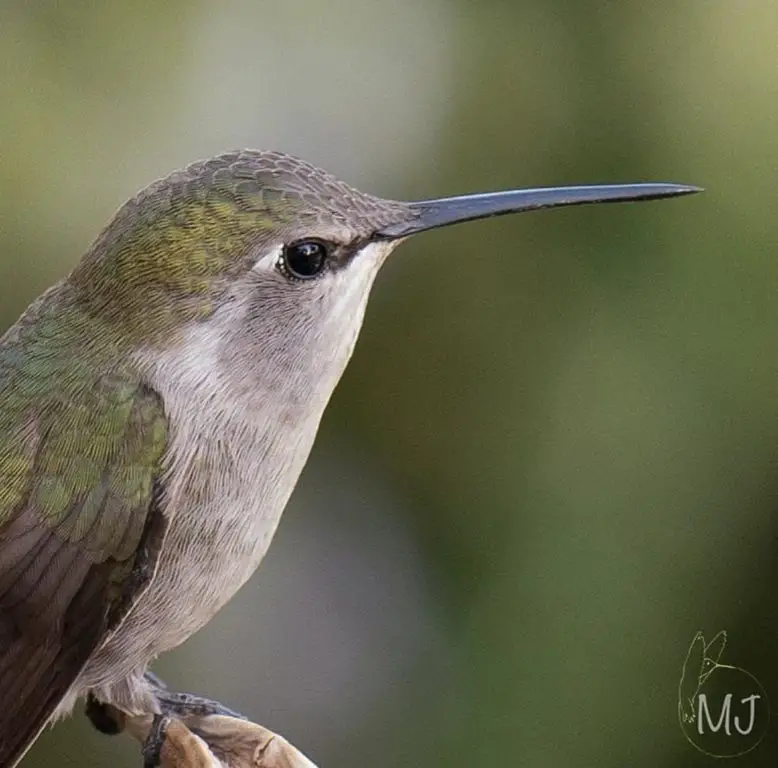
Photo by: hummingbirdsbysuprise
Female Costa’s hummingbirds migrate north to breed. They are a desert-dwelling species and build their nests in open areas with scarce vegetative cover. They have been known to nest on the tops of cacti. The thorns of the plant act as a deterrent to predators that may attempt to eat the eggs or nestlings.
Their habitat consists of desert scrub and washes including grasslands where they thrive on desert plants or ocotillos.
Male Costa’s hummingbirds are extremely territorial and can come across as being the meanest sheriff in town, especially when defending “their” feeders. Their aggressive conduct is equivalent to the known quarrelsome and combative behaviors of the Rufous hummingbird.
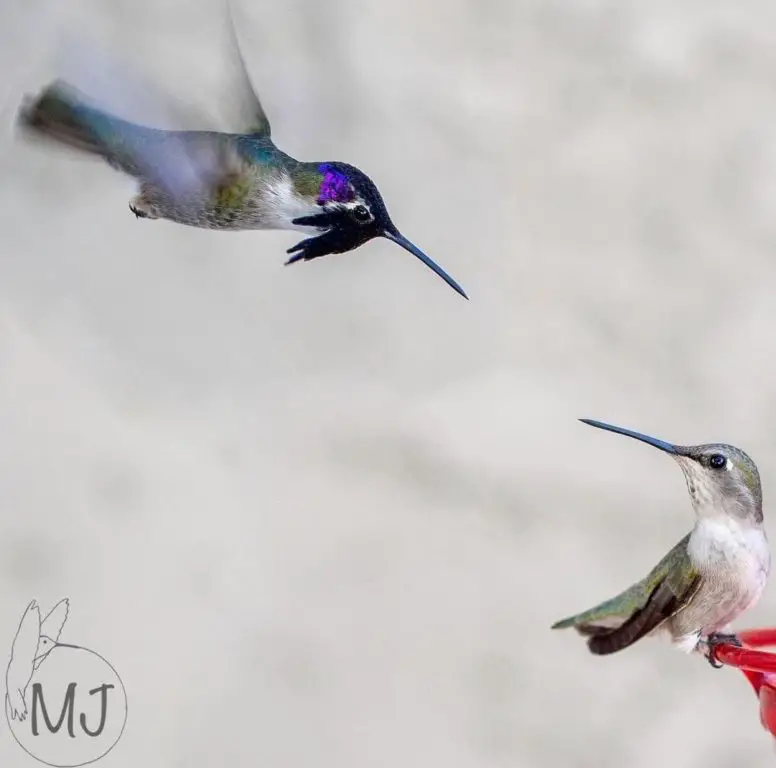
Photo by: hummingbirdsbysuprise
See my article: Why Hummingbirds Chase Each Other: Is it Friend or Foe?
Although Costa’s hummingbirds will defend nectar sources amongst themselves, they are subordinate to larger hummingbirds and will defer to them if challenged.
Costa’s hummingbirds have no known predators, however, the largest threat to Costa’s hummingbirds is human encroachment in the form of the desert being plowed and cleared for settlement and grazing.
They are known to interbreed and produce hybrids between Anna’s, Black-chinned, Calliope, and Broad-tailed hummingbirds.
See pictures of male, female and juvenile Costa’s hummingbirds here…..
Hear sounds of Costa’s hummingbirds here…..
Rare/Vagrant Hummingbirds
This hummingbird classification is defined as hummingbirds residing in a group outside of their normal geographic range. Not only do these species of hummingbirds have a wide variety of specific geographic ranges, but they are also known to sometimes interbreed with each other creating hybrids.
BROAD-BILLED HUMMINGBIRD – (Cynanthus latirostris)
Conservation Status: Least concerned
Kingdom: Animalia
Phylum: Chordata
Class: Aves
Order: Apodiformes
Family: Trochilidae
Genus: Cynanthus
Species: C. latirostris
Broad-billed hummingbirds travel frequently to the United States near the southern Mexican border, however, few rare/vagrants migrate and travel to Oregon.
Sightings map shows the Broad-billed hummingbirds have documented Oregon sightings in the areas of Kansas City, Manhattan, and Garden City.
Male Broad-billed hummingbirds feature a bright blue-green gorget that spreads back towards their shoulders. Juvenile males show off a full charcoal dark grey body with flecks of metallic blue on their throat and a light green neck and backside. They sport a long beak that is bright orange-red accented with a signature black tip. Their size ranges from 3.25 inches to 4 inches in length and weighs 3-4 grams.
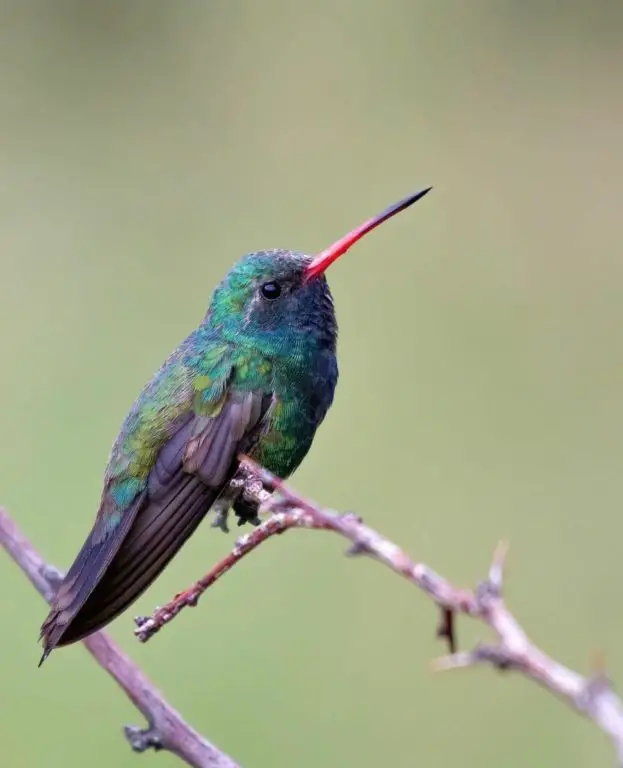
Photo by: Aaron Gomperts
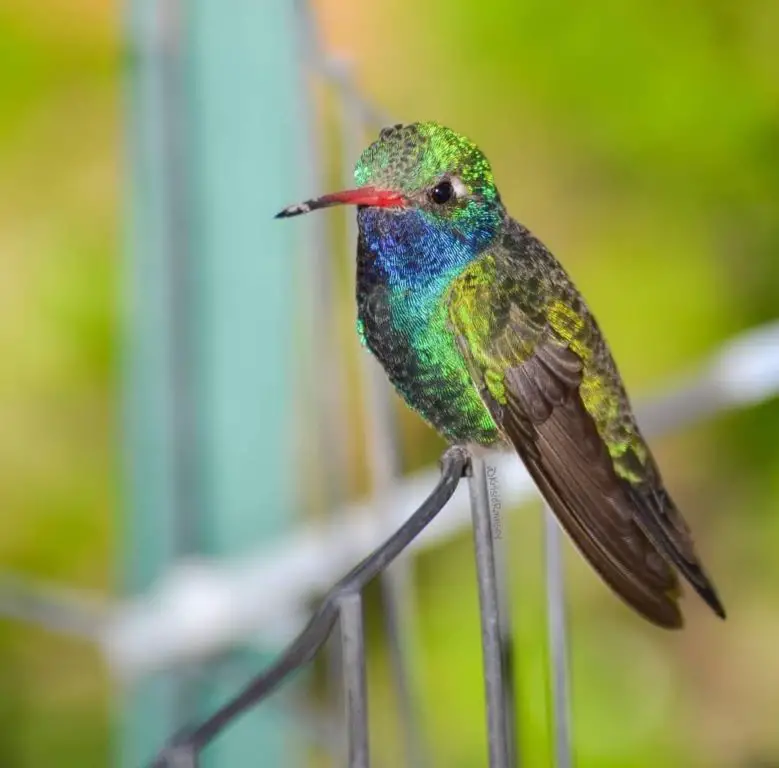
Photo by: krisieramsey
Female Broad-billed hummingbirds are identified with a completely dark bill and a longer white accent above the eyes.
Juvenile male and female Broad-billed hummingbirds are both predominantly metallic green on their topside with a white underbelly. Their tails are dark in color and forked.
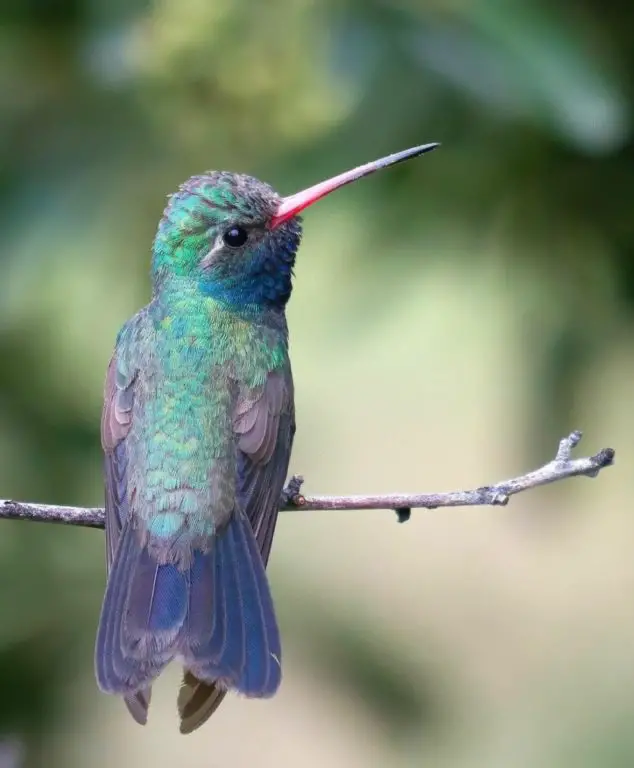
Photo by: Aaron Gomperts
Broad-billed hummingbird nests are distinguishable because they do not decorate the outside of their nests with lichens but instead choose to construct their nests with outside grass fibers, bits of leaves, and bark while using spider webs to glue and hold the nest together. The nest that the female builds hang on a single long slender branch.
Astonishingly, unlike other hummingbird population counts, the Broad-billed hummingbird has shown an actual general population increase in recent years.
In Arizona, the oldest recorded male Broad-billed hummingbird was 9 years and 1 month old when he was captured and released from a banding operation.
See my article: 3 Reasons Why Hummingbirds Are Banded
See pictures of male, female, and juvenile Broad-billed hummingbirds here…..
Hear sounds of Broad-billed hummingbirds here…..
RUBY-THROATED HUMMINGBIRD – (Archilochus colubris)
Conservation Status: Least concerned
Kingdom: Animalia
Phylum: Chordata
Class: Aves
Order: Apodiformes
Family: Trochilidae
Genus: Archilochus
Species: A. colubris
Ruby-throated hummingbirds are rarely documented in Oregon. Their main residence is mostly in the midwest and on the east coast of the United States.
Sightings map documents the Ruby-throated hummingbird in Oregon in an area north of Pendleton southward to Piolet Rock, east of Valley Falls, and in cities around Bear Valley National Wildlife Refuse of Fairhaven/Midland/Keno/Worden.
The Ruby-throated hummingbird’s scientific name originated from Carl Linnaeus, a Swedish botanist, who first listed this scientific classification as “Trochilus colubris”. Its name changed over a hundred years later and was reclassified by Ludwig Reichenbach, a German botanist to “Archilochus colubris”, which is its current scientific name, meaning “top thief” or “sky spirit/sun-god bird”.
Male Ruby-throated hummingbirds have a striking iridescent blood-red gorget, stopping at the neckline. He is identified with a dull metallic green topside, a light gray underbelly, and black wings. The Ruby-throated hummingbird is a smaller species of hummingbirds weighing less than 4.5 grams or 2 U.S. dimes and is 2.8 to 3.3 inches in length. Their lifespan is approximately 3-5 years.
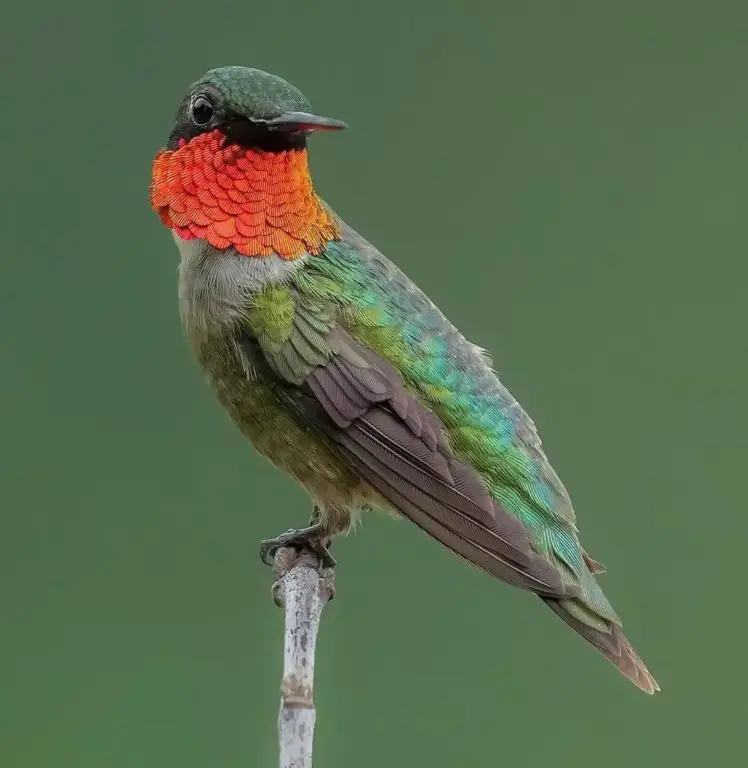
Photo by: andy_raupp
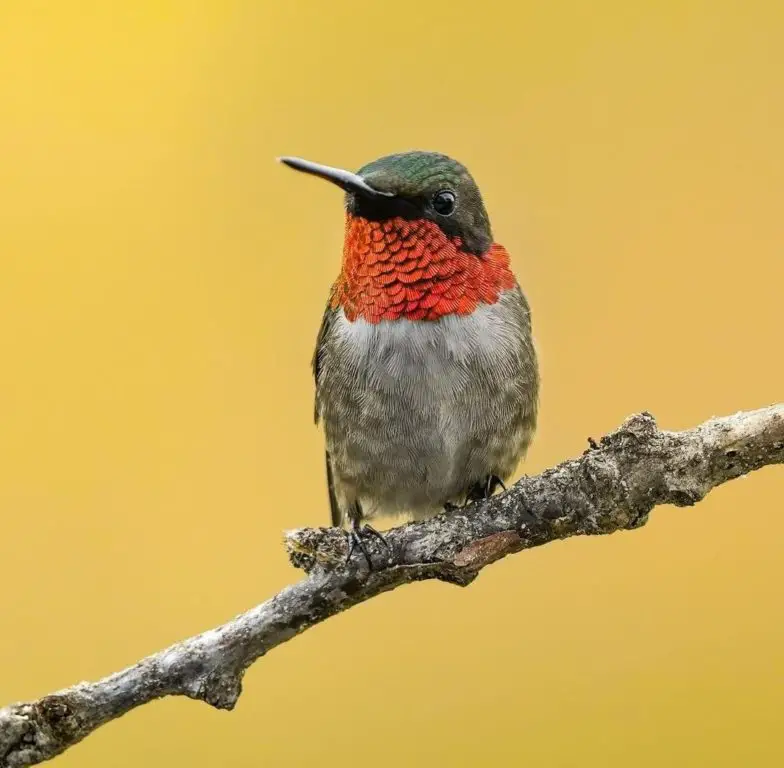
Photo by: andy_raupp
Female Ruby-throated hummingbirds have a white throat with some light stippling and are typically larger than the males. The oldest female Ruby-throated hummingbird has been recorded at 9 years, almost double that of the male.
However, the average lifespan of a Ruby-throated hummingbird is approximately 3-5 years.
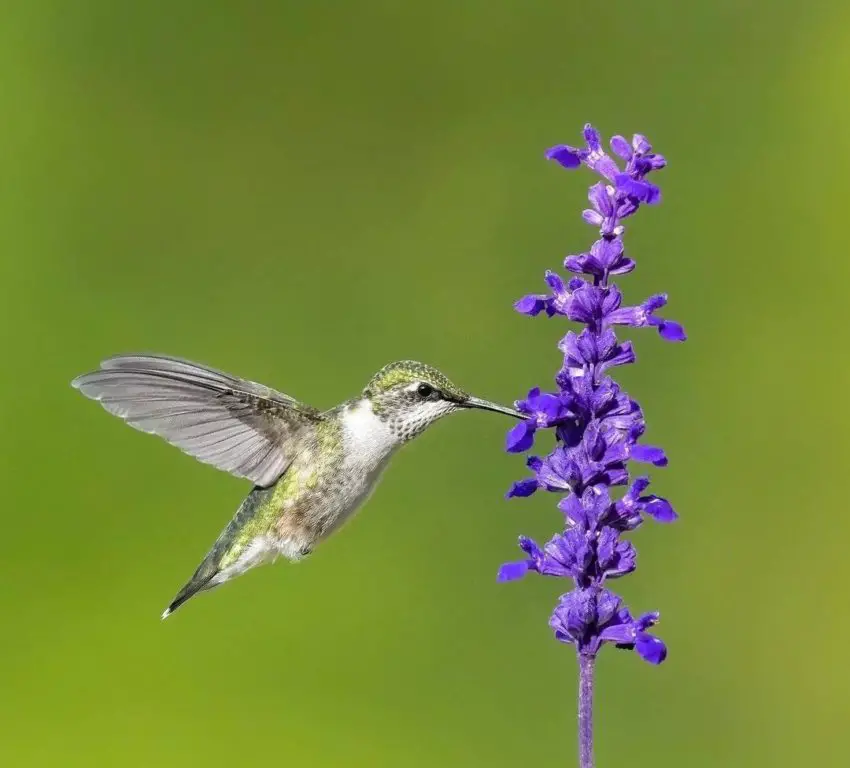
Photo by: andy_raupp
Note: The flower that this female Ruby-throated hummingbird is drinking from is called Salvia – ‘Rhea’.
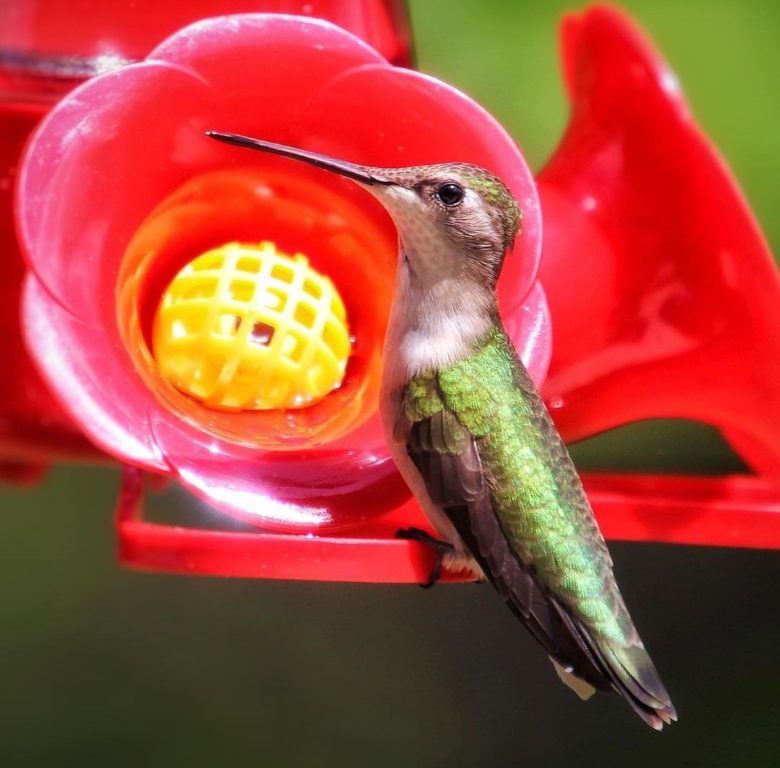
Photo by: paulapaintsart
Juvenile male and female Ruby-throated hummingbirds during their initial stages of life resemble their mother exhibiting a white throat with light stippling.
As the males mature, they begin to display a few specks of color near their neckline and eventually their bolder red throat feathers become more dominant and stately displaying a colorful gorget.
Juvenile females show a light faint grey stippling on their throat. As both sexes mature their less vivid and lighter colored plumage will begin to mature and become darker in color.
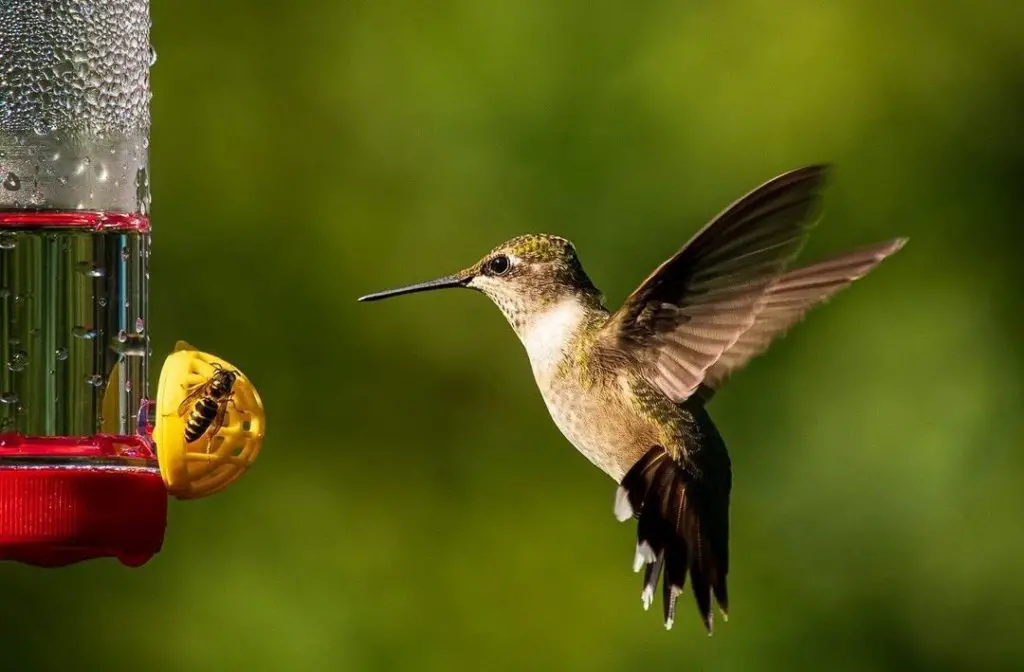
Photo by: MaryLou Ziebarth
Note: This juvenile Ruby-throated hummingbird is struggling with a bee or wasp situation at the feeder.
See my article: Bees On My Hummingbird Feeder: (9 Tips To Get Rid of Them)
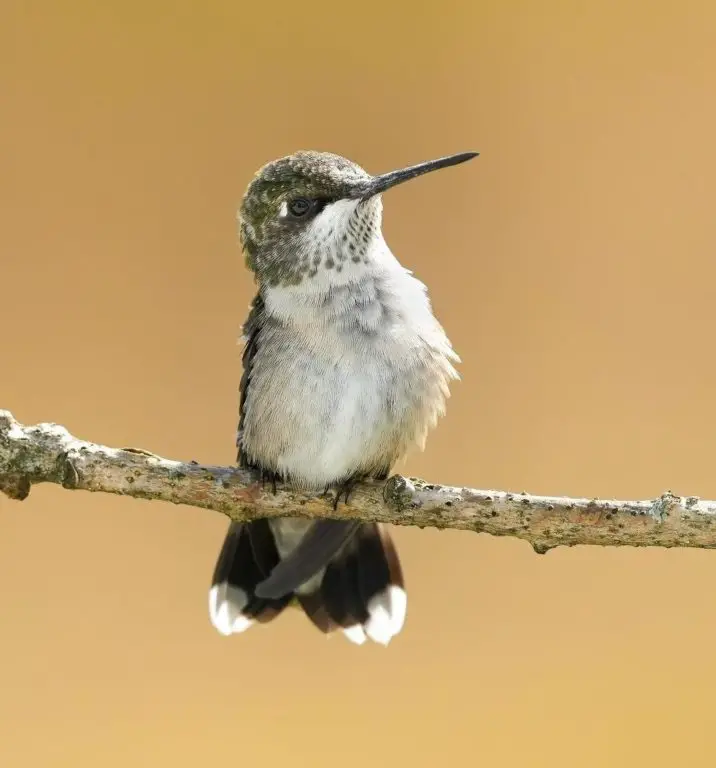
Photo by: andy_raupp
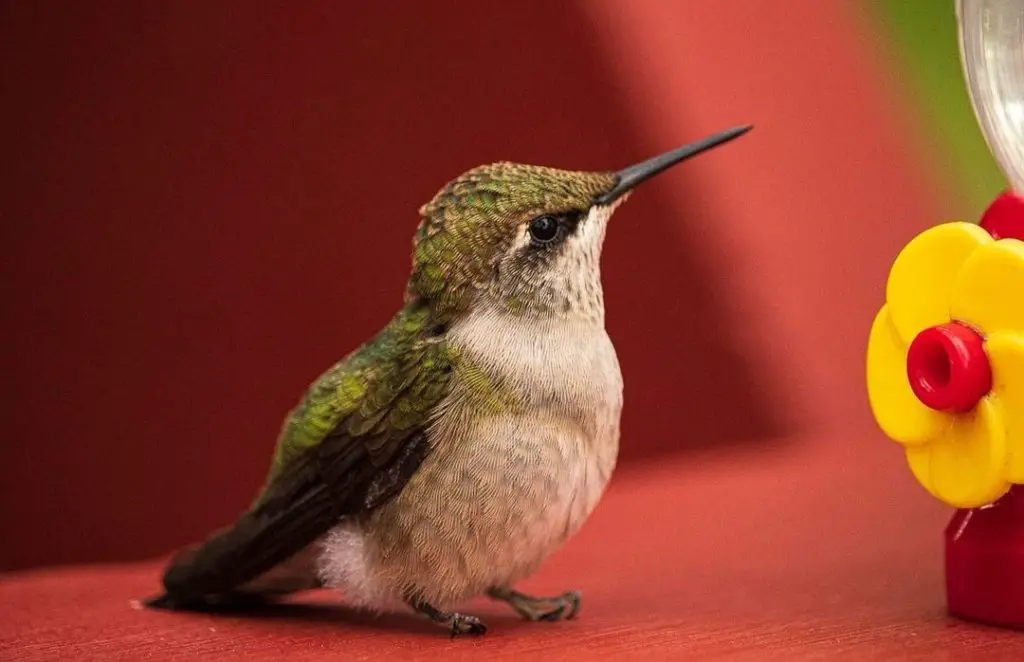
Photo by: MaryLou Ziebarth
Note: The newly white fluffy down feathers on this baby/juvenile Ruby-throated hummingbird’s bottom. Also, notice the nice fat reserves they have accumulated by being fed by their diligent mother which will sustain them through adolescence.
There are two migration routes for the Ruby-throated hummingbird during the spring and fall migrations.
The first migration route is a direct but exhausting nonstop journey southwest over the Gulf of Mexico to Mexico and then down to Central America for the winter. The flight distance over the Gulf of Mexico is over 500 miles. Although this is the direct “short” route, there are numerous obstacles faced by these birds.
Some obstacles include not being able to rest, no means to refuel or eat and having to avoid the dangerous tropical Atlantic hurricanes while flying to their destination. To make matters worse, depending on how you look at it, they migrate during the dark hours of the night or are taking the “Red-eye flight”.
Researchers believe their small size makes the energy expenditure of their grueling trans-oceanic migration pattern more taxing for males than for females even though they both double their body’s fat prior to making the migration across the Gulf of Mexico.
The second migration route is over 2,000 miles, flying along the coastline outlining the Gulf of Mexico. Although this is the “long” route, it allows the opportunity to rest and refuel even though there are fewer food source guarantees along the way.
Scientists are unclear and continue to investigate as to why one group of birds would prefer to take one route over the other.
See my article: Hummingbird Migration in Oregon
Ruby-throated hummingbirds prefer open woodlands and are often seen in parks, gardens, and backyards. They are solitary birds except during mating periods when they are fiercely territorial and aggressive towards hummingbirds of other species.
Even though these hummingbirds have an aggressive side they can still be eaten by predators such as large invertebrates, praying mantises, orb-weaver spiders, and dragonflies.
See my article: 10 Common Things That Kill Hummingbirds
See pictures of male, female, and juvenile Ruby-throated hummingbirds here…..
Hear sounds of Ruby-throated hummingbirds here…..
Happy Hummingbird Watching!
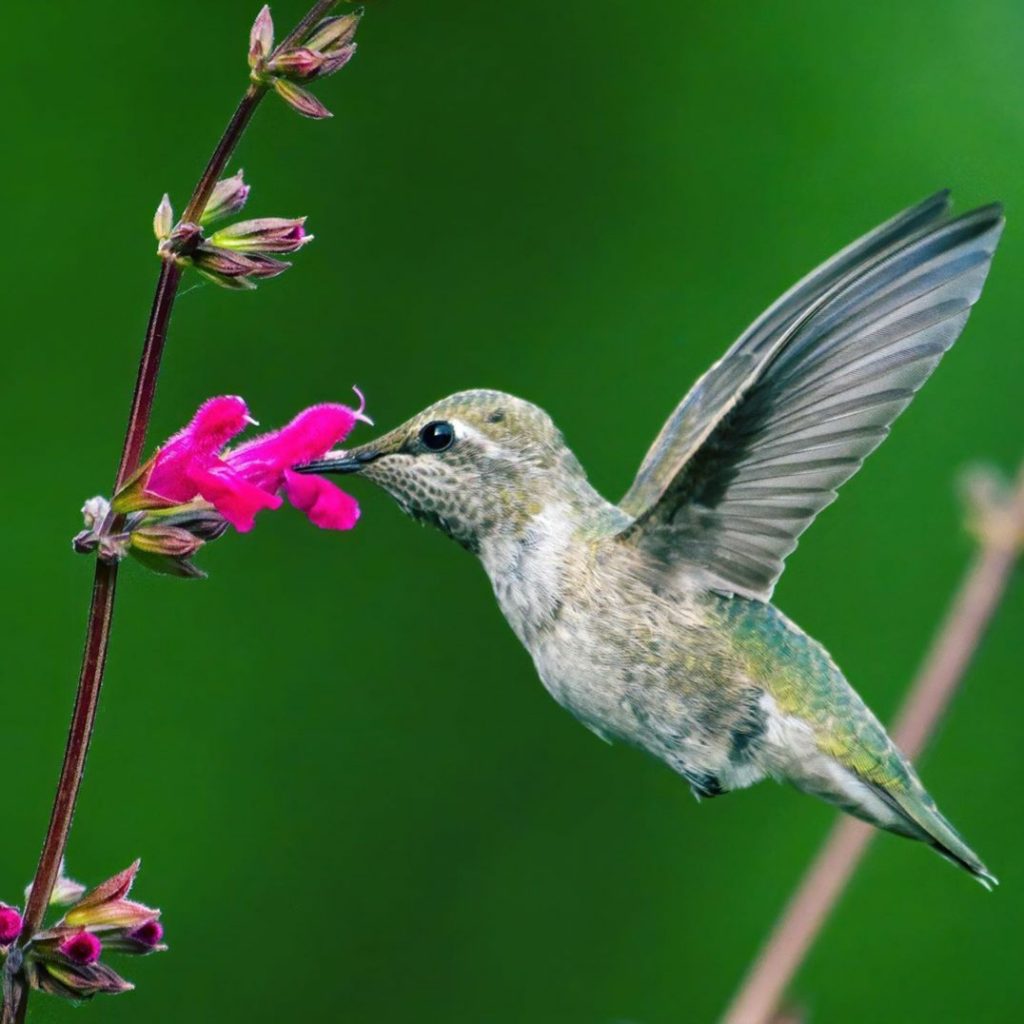
Taken in: Eugene, Oregon
Photo by: halsadofsky
Backyard Visitors participates in affiliate programs which compensate us for referring traffic.

